
e UK’s wealth distribution
and characteristics of high-
wealth households
Arun Advani, George Bangham & Jack Leslie
December
@resfoundationresolutionfoundation.org
BRIEFING

Download
This document is available to download as a free PDF at:
https://www.resolutionfoundation.org/publications/
Citation
If you are using this document in your own writing, our preferred citation is:
A Advani, G Bangham & J Leslie,
The UK’s wealth distribution and characteristics of high-wealth households: Reports are fun,
Resolution Foundation, December 2020
Permission to share
This document is published under the Creative Commons Attribution Non Commercial No
Derivatives 3.0 England and Wales Licence. This allows anyone to download, reuse, reprint,
distribute, and/or copy Resolution Foundation publications without written permission subject to
the conditions set out in the Creative Commons Licence.
For commercial use, please contact: info@resolutionfoundation.org
Acknowledgements
This research was funded by the Economic and Social Research Council
(ESRC) through the CAGE at Warwick (ES/L011719/1) and a COVID-19 Rapid
Response Grant (ES/V012657/1), by LSE International Inequalities Institute
AFSEE COVID-19 fund, and by the Standard Life Foundation. The authors
thank Hannah Tarrant and Helen Hughson for outstanding research
assistance, and Emma Chamberlain, Carla Kidd, Salvatore Morelli, and Andy
Summers for helpful comments. This work contains statistical data from ONS
which is Crown Copyright. The use of the ONS statistical data in this work
does not imply the endorsement of the ONS in relation to the interpretation
or analysis of the statistical data. This work uses research datasets which may
not exactly reproduce National Statistics aggregates. All errors remain the
author’s own.
2
The UK’s wealth distribution and characteristics of high-wealth households |
Resolution Foundation

3
Introduction
In high-income Western economies during much of the twentieth century, economic
questions of distribution – of income or other variables – seemed of secondary
importance to those of macroeconomic growth. This focus for research was more
understandable in an era of economic expansion, broadly rising living standards and
falling inequality. But in the past 40 years trends of falling inequality have faltered or even
reversed. More recently, trends in growth and productivity have slowed down too. With a
lag, economists’ interests have followed suit: high-profile research on income distribution
paved the way for a more recent wider focus on other types of inequality such as that of
wealth, particularly since the publication of Capital in the Twenty-First Century (Piketty,
2014). This research has led policymakers to think more about the distribution and
growth of wealth, as well as options for taxing it.
This paper sets the scene for the broader project by examining the distribution of wealth
in the UK today.
1
It considers the three types of data that are available to researchers
looking at the wealth distribution – household surveys, administrative data from income
and inheritance tax, and lists of large wealth-holders – and then looks at what the first of
these can tell us about the ownership of wealth. It also discusses the limitations of the
different methods for studying the amount and distribution of wealth, and demonstrates
with a Pareto distribution-based extension of the available data that true levels of wealth
(and of wealth inequality) are likely to be higher than those shown in the conventional
statistics.
A detailed understanding of the distribution of wealth matters when designing wealth
taxes in at least three distinct ways. First, it helps policymakers to gauge the likely welfare
impact of changes to the tax regime for wealth and particularly what the characteristics
of people affected would be with respect to present income, age, location and other
key variables. Second, the distribution of wealth is itself a key determinant of people’s
living standards, at least as much as the more often-studied income. Holding wealth
not only permits people to smooth their consumption and insure against risk, but also
confers direct benefits for personal wellbeing and life chances (and those of someone’s
descendants): the so-called ‘asset effect’ (McKnight and Karagiannaki, 2013). Third,
1 Though we refer to the UK throughout this paper, our data exclude Northern Ireland, Northern Scotland (north of the Caledonian
canal), and individuals living in residential institutions such as prisons, university accommodation, and care homes. As a result,
we miss around 2% of the UK population. Unless these areas are drastically different from the rest of the UK, it is unlikely that
our distributional results are substantially affected. In principle, if the distribution of wealth in these areas is identical to what we
observe elsewhere, we could increase our aggregate measures of wealth by 2%, but given the inherent uncertainty involved in
using survey data, we do not take this approach, and we do not expect it to change our results substantially. We do include some
of the wealthiest individuals in the areas omitted from the survey data, as these individuals are captured in the Sunday Times Rich
List which we use to supplement our estimates.
The UK’s wealth distribution and characteristics of high-wealth households |
Resolution Foundation

4
the combination of tax structure and wealth distribution (along with any behavioural
responses to the tax) determine how much revenue will be raised.
Distributional analysis of wealth ownership demands a dataset that measures both
wealth and other personal characteristics. At present, the ONS Wealth and Assets Survey
is the only such comprehensive dataset available for Great Britain,
2
so it forms the core of
our analysis. We find that the top three household net wealth deciles held a larger share
of wealth in 2016–18 than ten years earlier, and the middle 50% shrank. This has been
driven by rising financial wealth relative to property wealth. Importantly, average gains in
financial wealth over the past decade are explained more by passive capital gains than
by active saving,
3
and wealth gains have accrued mostly to families that already held
financial assets. We find that a major driver of rising inequality is that wealthy families’
financial portfolios will contain a greater share of high-yielding assets (consistent with
Bach, Calvet and Sodini, 2020; Fagereng et al., 2020), and show that population ageing
alone does not explain very much of the recent change in the distribution of wealth.
Lower wealth households (the second and third net wealth decile) have a larger share of
wealth in physical assets (largely consumer durables) than in other broad asset classes,
while wealth for the fifth to eighth deciles is dominated by property, and for the top
two deciles dominated by pensions. Financial wealth is much more prevalent in the
wealthiest decile, and its composition varies substantially across net wealth deciles,
though even the wealthiest families have a significant share in low-yielding assets.
We also consider the characteristics of high-wealth households who would likely be
impacted by the introduction of a wealth tax, and the types of wealth they hold. They
are clustered in working-age cohorts close to retirement, and are more likely to be male
than female. There are large geographical divides, with high-wealth families much more
concentrated in the South East of England than in the rest of Great Britain. There is also
low volatility in wealth rank: only 7% of families in the bottom half of the distribution in
2014–16 moved into the top half two years later. Finally, the composition of high-wealth
families’ wealth holdings is much more dominated by business and financial assets (and
relatively less by property and pensions) for those families with net wealth over £5 million
per adult than for families with lower wealth levels.
A well-known problem with household surveys is that it can be difficult to capture
a complete representative sample of all individuals. We explore this problem, with a
particular focus on the very wealthiest families in the UK, using the Sunday Times Rich
List. Our analysis finds that the ONS’s Wealth and Assets Survey does a remarkably good
2 Unfortunately, there is no comprehensive survey of wealth in Northern Ireland comparable to the ONS Wealth and Assets Survey,
though Hillyard, Patsios and Feely (2014) do provide some evidence on wealth held in Northern Ireland to which the interested
reader may refer.
3 See Corlett, Advani and Summers (2020) for more information on capital gains.
The UK’s wealth distribution and characteristics of high-wealth households |
Resolution Foundation

5
job at capturing some of the wealthiest people in the UK but that there is likely to be at
least some undercount in official estimates of total wealth. Further, we find evidence
from fitting a Pareto distribution to UK wealth data (often found to be a good fit of the
upper wealth tail of the wealth distribution in a range of contexts) that both the Wealth
and Assets Survey and the Sunday Times Rich List underestimate family wealth at the
very top of the distribution. Adjusting for these deficiencies by adding in wealth captured
in the Rich List that is not captured in the Wealth and Assets Survey, and subsequently
accounting for additional missing wealth using a Pareto adjustment, increases survey
estimates of total wealth by 5% in our central estimate, adding almost £800 billion in
wealth. Around half of this comes from simply adding wealth captured in the Rich List
that is not recorded in the Wealth and Assets Survey.
The rest of the paper proceeds as follows. Section 2 details the available data in the UK
on household wealth, and the approach we have taken to analyse it. Section 3 describes
the size and distribution of household wealth in the UK. Section 4 analyses the gaps
in the available data, and the impact on estimates of the wealth distribution after
accounting for deficiencies in data coverage. The conclusion summarises our findings
and their implications for the rest of the project.
Data and methodology
The primary challenge in understanding the scale and distribution of wealth in the UK
is the data available for research. Broadly speaking, there are three key types of data:
first, survey-based data collecting households’ self-reported wealth holdings – key here
is the Office for National Statistics’ (ONS) Wealth and Assets Survey (WAS); second,
administrative data collected for tax purposes, one example is the data on the value of
estates at death for inheritance tax; and finally, data compiled for other purposes such as
the Sunday Times Rich List (STRL). Each of the datasets entails significant challenges in
allowing us to produce comprehensive estimates of the distribution of wealth in the UK
(for a wider discussion see Alvaredo, Atkinson and Morelli, 2016).
Survey data
The WAS provides the most comprehensive wealth data available in the UK, both in
terms of who it covers and what assets are covered. It has been conducted since 2006
with the purpose of capturing very granular information on the value of household
wealth – both assets and liabilities – at the individual and household level. The ONS
produces summary statistics and allows researchers access to anonymised microdata.
4
This allows us to produce detailed analysis by asset and liability type broken down by key
characteristics of the individual or household.
4 See, for example, ONS (2020).
The UK’s wealth distribution and characteristics of high-wealth households |
Resolution Foundation

6
The WAS samples private households with an address in Great Britain. In principle, this
means the survey could capture those who only live in Great Britain part-time who are
not strictly ‘resident’, though in practice it is unlikely that many such individuals respond
to the survey. Individuals who are resident but non-citizen are also within the scope of
the survey.
5
The survey is unlikely to fully capture the wealth of families where one family
member lives outside the UK, as this individual would not be interviewed or classified
as a member of the household, and their wealth (unless owned jointly with an eligible
household member) would not be captured. The sample excludes individuals living in
residential institutions, such as retirement homes, nursing homes, prisons, barracks
or university halls of residence, and homeless people. We therefore do not observe the
wealth of these individuals, who number approximately 1.2 million (Corlett et al., 2018).
There are three major challenges that face researchers using the WAS. First, the time
series is relatively short which does not allow the data to be placed within its long-run
historical context. Second, it is hard to value some types of assets (largely non-financial
assets) which do not have a clear market price; the survey is designed to rely on the self-
reported subjective value of these assets which may introduce biased valuations.
6
Third,
and perhaps most importantly for this paper, some wealth is unlikely to be captured by
the WAS. This is due to unit non-response where richer households are less likely to
respond to the survey,
7
item non-response where survey respondents fail to include their
assets, particularly business assets, and indirect holding of wealth through trusts and
other vehicles, particularly at the very top of the distribution. Despite these challenges,
the WAS remains the best source of data on the wealth holdings across much of the UK’s
wealth distribution; indeed, since its inception, the survey has formed the bedrock of
much of the recent analysis of wealth in the UK, for example, Crawford, Innes and O’Dea
(2016) and D’Arcy and Gardiner (2017).
Administrative data
For analysing changes to existing taxes, administrative data has the clear advantage of
covering the full population of those paying the tax. But the UK does not have an existing
comprehensive wealth tax meaning that there is no complete administrative dataset on
wealth holdings in the UK. Inheritance tax data are available for taxable wealth held at
death by people whose estates require probate.
8
Capital income taxes (taxes on income
from wealth) mean administrative data also cover wealth which produces taxable income,
5 We discuss data issues relating to residency and citizenship further in Section 4.3.
6 Appleyard and Rowlingson (2010) note that there is some evidence of overestimating the value of housing in early waves of the
WAS, and the same appears to be true in later waves (ONS, 2018). We discuss this issue further in Section 4.3).
7 The ONS attempt to account for lower response rates among wealthier households by over-sampling households identified ex
ante as likely to be in the wealthiest tenth of households.
8 Despite the name, inheritance tax (IHT) data cover all estates requiring probate, regardless of whether any IHT is due on the estate.
This means that they cover estates valued below the exemption threshold for IHT (currently £325,000), if probate is required on at
least one of the assets making up the estate.
The UK’s wealth distribution and characteristics of high-wealth households |
Resolution Foundation

7
from which it is possible to estimate the value of the underlying asset,
9
but assets which
don’t generate income will be missed, such as owner-occupied homes. While consistency
of definition and legal requirements to report ensure that administrative data are of good
quality for individuals who are required to report, not all individuals, and not all assets, will
be covered: for example, relatively few estates pay inheritance tax. However, tax planning
may also affect the extent to which reported wealth captured accurately reflects the
wealth of the living population. For example, most lifetime gifts of cash do not need to
be reported however substantial, unless the donor dies within seven years, and such
transfers of wealth do not have to be shown on any probate forms or on the recipient’s
tax return.
Some of these administrative data have been used to analyse the top of the UK’s wealth
distribution in previous research – specifically inheritance tax data. Alvaredo, Atkinson
and Morelli (2018) estimate the share of wealth at the top of the distribution since the
nineteenth century, using ‘mortality multipliers’ that treat the deceased as a sample of
the living population. This approach is valuable as it would theoretically capture all high-
wealth estates and thus is not subject to the high-wealth unit non-response present
in the WAS. However, though inheritance tax data capture 100% of estates with an
inheritance tax liability, it may fail to capture the wealth held in estates valued above the
exemption threshold (currently £325,000 per person) if no inheritance tax is due, even
if probate is required. This is because non-taxpaying estates, such as those where the
deceased is resident but non-domiciled,
10
or estates claiming exemptions and reliefs,
11
are not necessarily required to report all assets. A further concern is that the wealth
observed on death is not representative of the wealth of the living as individuals nearing
death may engage in ‘deathbed planning’.
But the major drawback, in so far as we would want to study the whole wealth
distribution, is that inheritance tax data fail to capture key parts of it. Inheritance tax data
only cover estates requiring probate, which is roughly half of all estates passing on death
(HMRC, 2019, p.4). Many smaller estates do not require probate, nor do estates which are
jointly held and pass automatically to the surviving spouse (potentially including some
high-value estates). There are no hard rules determining whether probate is required,
and it is difficult establish how probate incidence, and thus inclusion in the data, varies
across the wealth distribution. Estates data also do not cover all asset classes, with
9 This approach estimates the level of wealth across the distribution by applying asset return rates to more readily observed capital
income. However, it is very sensitive to assumptions about the rate of return, with small differences in return rate assumptions
leading to large changes in estimated wealth – see Smith, Zidar and Zwick (2020), and Saez and Zucman (2020a, 2020b).
10 If the deceased is non-domiciled, inheritance tax is only due on assets located in the UK, and they are not obliged to report the
total value of worldwide assets. Conversely, the data include the estates of individuals who are domiciled but are not resident in
the UK, as these are chargeable to IHT.
11 Some assets classes receive full tax relief (such as agricultural and business property); while data is available for these assets, they
may not properly reflect true values because the tax authority has no incentive to check submissions given their exclusion from
tax liability.
The UK’s wealth distribution and characteristics of high-wealth households |
Resolution Foundation

8
pension assets and some assets held in trust being excluded. This means that the data
are insufficient for the purpose of this paper to summarise the entire wealth distribution.
Adjusting top wealth
The approach taken in this paper is to rely on the WAS as the basis for the primary
analysis – see Section 3 – as it is the most comprehensive and detailed summary of
household wealth. Following these results, we provide analysis of the scale of any
missing wealth not covered by the WAS and indicative results after adjusting for these
gaps – see Section 4.
In order to calculate the amount of wealth at the top of the wealth distribution which is
not captured by the WAS, we utilise the STRL which provides summaries of the wealth
held by the wealthiest individuals and families in the UK. Unfortunately, these two
datasets are not completely comparable; this is unsurprising given that the STRL data is
produced primarily from holdings of business assets and does not include other asset
types, such as housing (Watts, 2020). Therefore the STRL is best thought of as a lower
bound on the wealth levels of the very wealthiest families in the UK.
12
Combining the STRL and the WAS will capture more of the wealth distribution than either
does alone but it is possible that there will be wealth holdings which are not properly
captured by either dataset. In order to estimate this potential gap, we utilise an approach
taken by Vermeulen (2018) and Bach, Thiemann and Zucco (2019). This approach
assumes that the top tail of the wealth distribution matches a Pareto distribution, which
is commonly found to be the case for both the wealth and income distributions (Jones,
2015). The Pareto distribution is estimated using the combined WAS and STRL sample.
The total estimated wealth under the full Pareto distribution is then compared to the
survey data – if the data is found to underestimate total wealth relative to the Pareto
distribution, then that represents the missing wealth not captured by either survey.
What wealth and for whom?
There are two final important methodological considerations: what assets are included
within the definition of total wealth and what is the appropriate economic unit to analyse.
While it would seem that defining someone’s wealth should be easy, in fact a judgement
needs to be taken on what is included within the definition of wealth. For example,
private pension assets are not readily convertible into other forms of wealth for someone
of working age and therefore have no direct impact on living standards, although
12 STRL data are (in some cases) reported for ‘families’ rather than individuals or households as defined in WAS. In our analysis of
the combined WAS and STRL data, we use household-level WAS data, and assume each observation in the STRL represents one
household. It is also worth noting that anecdotally there are a number of very high wealth families who are not covered by the STRL
data, not least because they may use vehicles such as trusts and foundations to hold wealth, making it difficult to identify their
wealth.
The UK’s wealth distribution and characteristics of high-wealth households |
Resolution Foundation

9
awareness of future pension receipts may affect one’s current desire to save. There is
no inherently correct answer but we have taken an approach which attempts to be as
comprehensive as possible. This means our primary definition of net wealth includes
all private pension assets, financial assets, other business assets, physical assets and
property assets net of formal and informal financial liabilities.
13
We do not include a
measure of the expected individual value for future public pension payments. Clearly
there is a relationship between the existence of public sector pensions and household
saving decisions (Lachowska and Myck, 2018) but there is no contractual obligation for
the government to maintain future pension payments at levels currently expected. In
which case, a consistent alternative to our approach would be to include the effective
value of an individual’s entitlement to the entire existing social security system. The
reasons we do not do this are twofold: this largely represents a level shift in wealth
holdings (albeit varying by age and other characteristics) and does not affect our analysis
of high wealth families, and this ‘wealth’ would not be relevant for a government if it were
considering introducing a wealth tax.
Finally, wealth can be measured for different economic units: individuals, families
(meaning single adults or couples with any dependent children) or households (meaning
everyone living in the same dwelling).
14
There are advantages and disadvantages of taking
different approaches. It is more natural to think about wealth as held by the family unit
given that resources are typically shared freely between members of a family. But there
tend to be differences between individuals within families – one obvious example is that
women tend to have much lower pension wealth as a result of lower average wages
and the likelihood of taking time out of the labour market for childcare (B&CE, 2019).
This means that analysis at the household or family level can under-represent some of
the inequalities in wealth holdings. Differences in the distribution of holdings across
definitions also matter for the revenue calculations of a wealth tax, depending on the
level at which it is planned to be levied. For the analysis which follows, we rely on wealth
per adult within family units. Appendices B, C and D repeat much of the analysis is
Section 3 based on alternative economic unit definitions.
13 Physical assets are inherently harder to value (e.g. replacement value vs market value vs insurance value) and the WAS survey
design does not always ask for consistent valuations for wealth. Since we wish to capture market value, we have reduced the
reported value of home contents, theoretically measured at replacement value, by 75% to be more consistent with market values
of other asset classes. This is likely a relatively conservative approach.
14 Often households and family units will overlap but not always – for example, family units would treat adult children living with
parents as separate families.
The UK’s wealth distribution and characteristics of high-wealth households |
Resolution Foundation
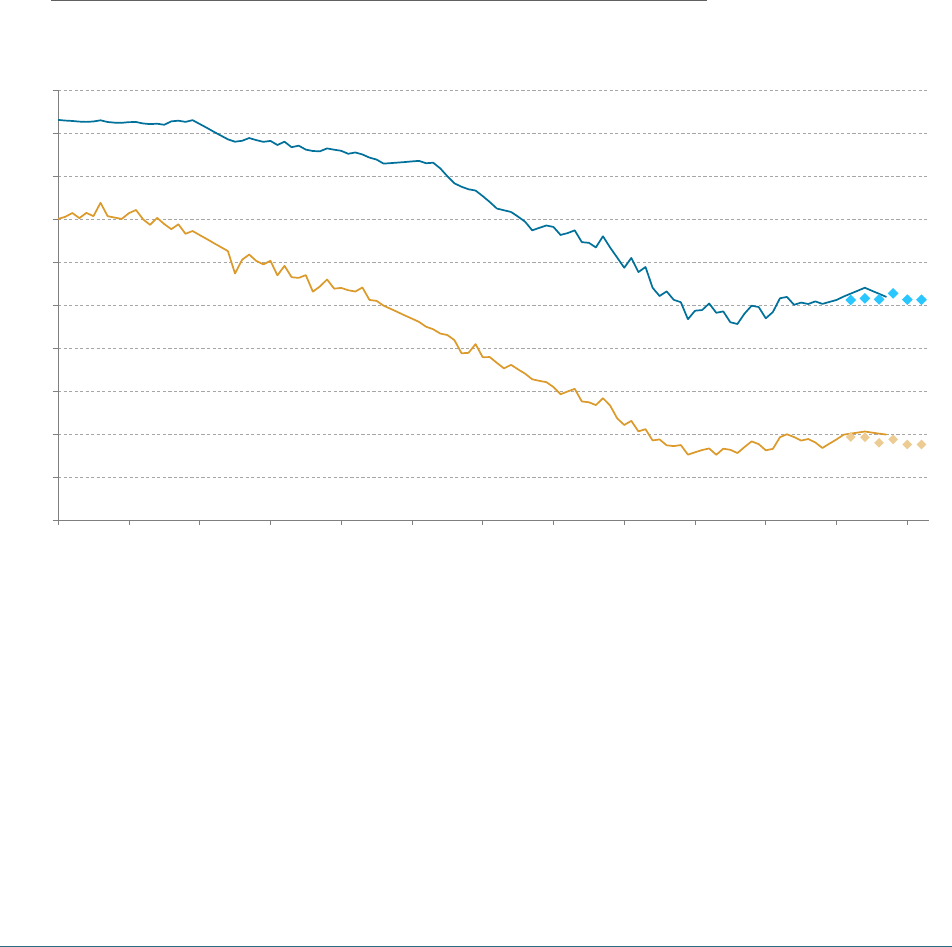
10
The distribution of UK household wealth
Inequality in household wealth
Household wealth in the UK is large and is held very unequally. Total net household
wealth as a share of national income has approximately doubled over the past thirty
years (Bangham and Leslie, 2020). Measures of wealth inequality suggest that it is twice
as unequally held as income (Crawford, Innes and O’Dea, 2016).
15
Understanding the size
and shape of wealth in the UK is vitally important for policymakers and is an important
context for the increasing interest in wealth taxes in the UK. This section explores the
topic in more depth.
FIGURE 1: Wealth inequality fell for much of the 20th Century
Share of net personal wealth held by richest one and 10 per cent: UK and GB
NOTES: World inequality database estimates refer to the whole of the UK and the WAS-based estimates
exclude Northern Ireland. Due to changes in the coverage of business assets between survey rounds in
the WAS, these results are adjusted using the latest observation of private business wealth shares held by
the top 10% and 1% in the most recent round of the survey (2016–18) and imputed backwards to provide a
consistent estimate. The definition of wealth used for the long-run estimates is not consistent with that
from the WAS; Appendix A provides alternative estimates of top wealth shares which address some of
these differences.
SOURCE: World Inequality Database, 2020; ONS, Wealth and Assets Survey.
Long-run estimates of the UK wealth distribution (Figure 1) show that the share of wealth
at the top of the distribution fell markedly during the early and mid-twentieth Century,
15 However, recent work by Advani and Summers (2020) suggests income inequality is being under-measured, so is somewhat closer
to wealth inequality.
1 per cent share
10 per cent share
WAS-based
estimate
WAS-based
estimate
0%
10%
20%
30%
40%
50%
60%
70%
80%
90%
100%
1895 1905 1915 1925 1935 1945 1955 1965 1975 1985 1995 2005 2015
The UK’s wealth distribution and characteristics of high-wealth households |
Resolution Foundation

11
since then top wealth shares have remained fairly stable.
16
This is a trend which has been
repeated across many countries (Piketty, 2014). It is partially a function of similar changes
in income inequality; naturally, those with higher income are more likely to be able to
save and thus accumulate wealth over time. But, as discussed later, there are significant
macroeconomic trends which influence the size of wealth and the shape of the wealth
distribution which are unrelated to the broader trends affecting income inequality. In
other words, more recent changes in wealth are less to do with income and saving than
they would have been in the past.
FIGURE 2: Wealth shares have fallen in the middle of the distribution
Share of total net family wealth by each net wealth decile since 2006-2008: GB
NOTES: Wealth is measured at the family level – single or couple adults and any dependent children
within a household. Total wealth includes net financial assets, net property assets, pension assets, and an
adjusted measure of physical wealth (including cars, home contents, collectibles, etc.). Private business
assets are excluded due to material improvements in the coverage of these assets since the early rounds
of the survey making cross-round comparisons difficult. Figure B1 shows the same graph constructed
using individuals as the unit of analysis.
SOURCE: ONS, Wealth and Assets Survey.
Drilling down into the available WAS data (which starts in 2006), we can see that there
has been a compositional shift in the wealth distribution: wealthier families hold a higher
share of wealth today than was the case a decade ago, while those in the middle hold
a smaller share of wealth (Figure 2). This shift is relatively small when compared to the
changes seen throughout the twentieth century. A commonly used alternative measure
of inequality, the Gini coefficient, has shown a very slight rise in inequality over this
16 We later show how these results are changed by the imputation of under-reported wealth. In Appendix A we also show that the
level and dynamics of wealth inequality in recent years depends on the definition of wealth used.
2008-10
2012-14
2016-18
-1.5ppts
-1.0ppts
-0.5ppts
0.0ppts
+0.5ppts
+1.0ppts
+1.5ppts
+2.0ppts
1
(lowest)
2 3 4 5 6 7 8 9 10
(highest)
The UK’s wealth distribution and characteristics of high-wealth households |
Resolution Foundation
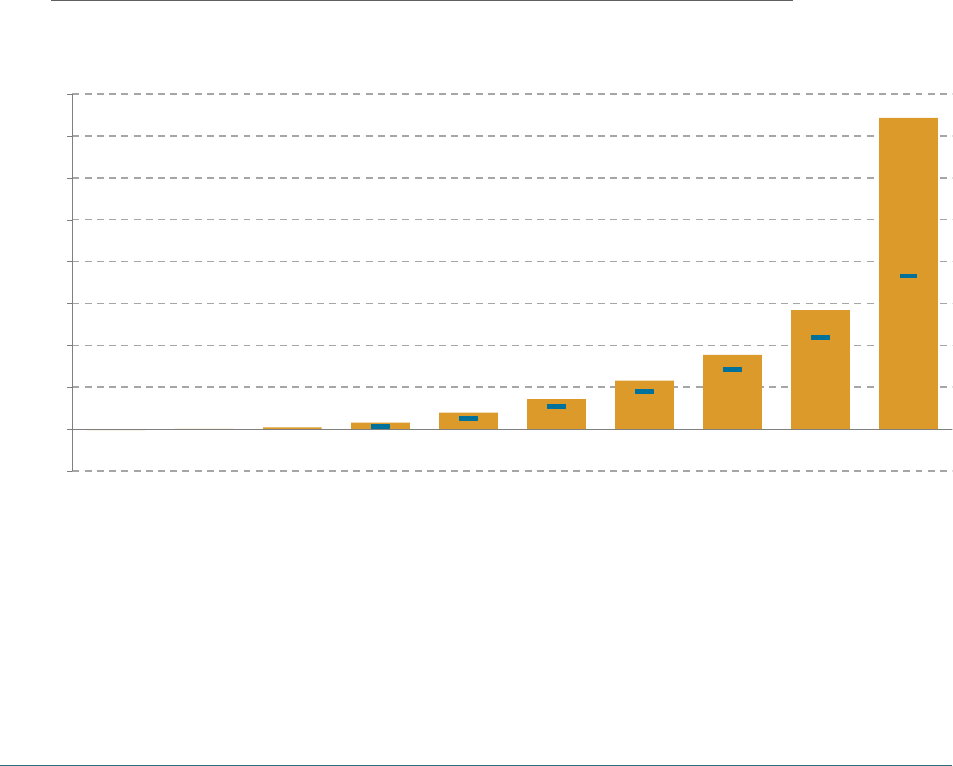
12
period, going from 0.61 in 2006–2008 to 0.63 in 2016–2018 (ONS, 2019a). This suggests a
smaller rise in inequality than that implied by the rise in share of wealth held at the top,
because the increase in top-wealth shares has been offset by small improvements at the
bottom of the wealth distribution.
Unsurprisingly, wealth levels vary substantially across the distribution. The average family
in the poorest 10% of families has negative net wealth – i.e. their debts exceed their
assets, while the median family has just over £100,000 in net wealth per adult and the
top 1% has almost £5 million per adult in the family.
17
Figure 3a and b show the average
wealth holdings for each adult within family groups across the wealth distribution. The
large gaps between families has a profound effect on living standards as well as mobility
across the wealth distribution. To put the scale of these gaps in context, the UK median
net disposable household income was around £23,000 in 2018–19 (Brewer et al., 2020);
it would require more than 400 years for the median household saving all disposable
income to move from median wealth to reach the average wealth of the richest 1%.
Figure 3a: Wealth holdings very widely across the wealth distribution
Average net wealth per adult per family within each net wealth decile: GB, 2016-2018
NOTES: Wealth is measured at the family level – single or couple adults and any dependent children within
a household. Total wealth includes net financial assets, net property assets, pension assets, business
assets and an adjusted measure of physical wealth (including cars, home contents, collectibles, etc).
Figures B2 and C1 show this graph using individuals and households as the unit of analysis, respectively.
Figure D1 shows this graph using an alternative wealth definition which excludes main homes and pension
wealth.
SOURCE: ONS, Wealth and Assets Survey.
17 Note that a family who are ‘just’ in the top 1% have £1.9 million wealth per adult. The mean per-adult wealth of a family in the
top 1% is much higher than this because it is an average that includes the extremely high wealth of those at the very top of the
distribution.
-£0.0m
£0.0m
£0.0m
£0.0m
£0.1m
£0.1m
£0.2m
£0.4m
£0.6m
£1.5m
-£0.2m
£0
£0.2m
£0.4m
£0.6m
£0.8m
£1.0m
£1.2m
£1.4m
£1.6m
1
(lowest)
2 3 4 5 6 7 8 9 10
(highest)
—
denotes minimum wealth within group
The UK’s wealth distribution and characteristics of high-wealth households |
Resolution Foundation
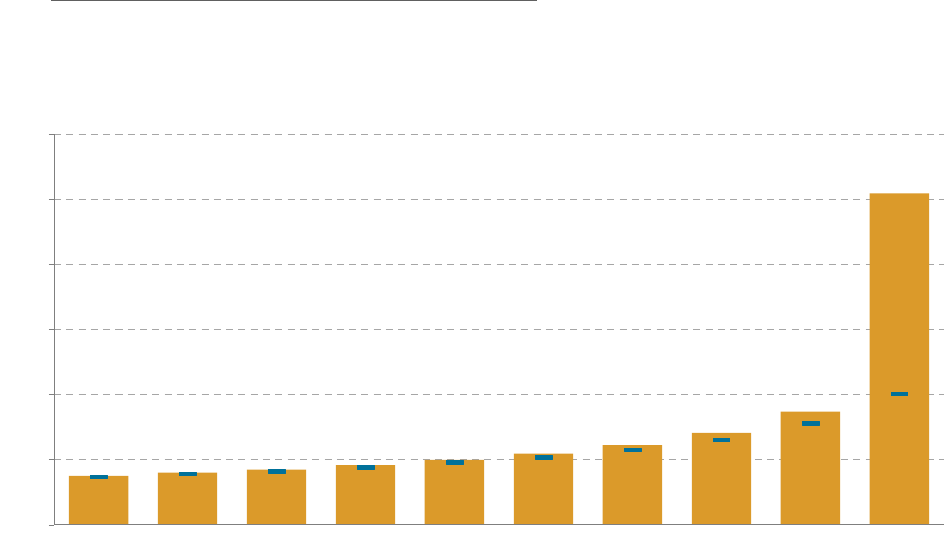
13
Figure 3b: The top 1 per cent are very wealthy
Average net wealth per adult per family within each net wealth percentile for the
wealthiest 10 per cent: GB, 2016-2018
NOTES: Wealth is measured at the family level – single or couple adults and any dependent children within
a household. Total wealth includes net financial assets, net property assets, pension assets, business
assets and an adjusted measure of physical wealth (including cars, home contents, collectibles, etc).
Figures B3 and C2 show this graph using individuals and households as the unit of analysis, respectively.
Figure D2 shows this graph using an alternative wealth definition which excludes main homes and pension
wealth.
SOURCE: ONS, Wealth and Assets Survey.
Composition of household wealth
Household wealth in the WAS is decomposed into five asset classes: property wealth
(net), physical wealth, private pension wealth, financial wealth (net), and business assets.
Net property wealth consists of self-valuations of any property owned by the household,
net of any loans or mortgages secured on the property. Physical wealth includes the
estimated value of all household contents, including antiques, artwork, and vehicles.
Private pension wealth is the value of all occupational and personal pensions, including
both defined contribution and defined benefit pensions, as well as pensions in payment.
Financial wealth includes the value of formal investments such as bank or building
society current or savings accounts, ISAs, endowments, stocks and shares, informal
savings, and childrens’ assets, less financial liabilities. This includes shares in public and
private corporations, the main source of wealth measured in the Sunday Times Rich List.
Business assets, in contrast, include the value of assets used within a business in which
the respondent is self-employed, or is a director or partner. This includes unincorporated
businesses, and is unlikely to closely match the STRL concept of ‘business wealth’, which
largely reflects shares in public or private corporations.
£0.8m £0.8m £0.8m £0.9m £1.0m £1.1m £1.2m £1.4m £1.7m £5.1m
£0
£1m
£2m
£3m
£4m
£5m
£6m
91 92 93 94 95 96 97 98 99 100
—
denotes minimum wealth within group
The UK’s wealth distribution and characteristics of high-wealth households |
Resolution Foundation
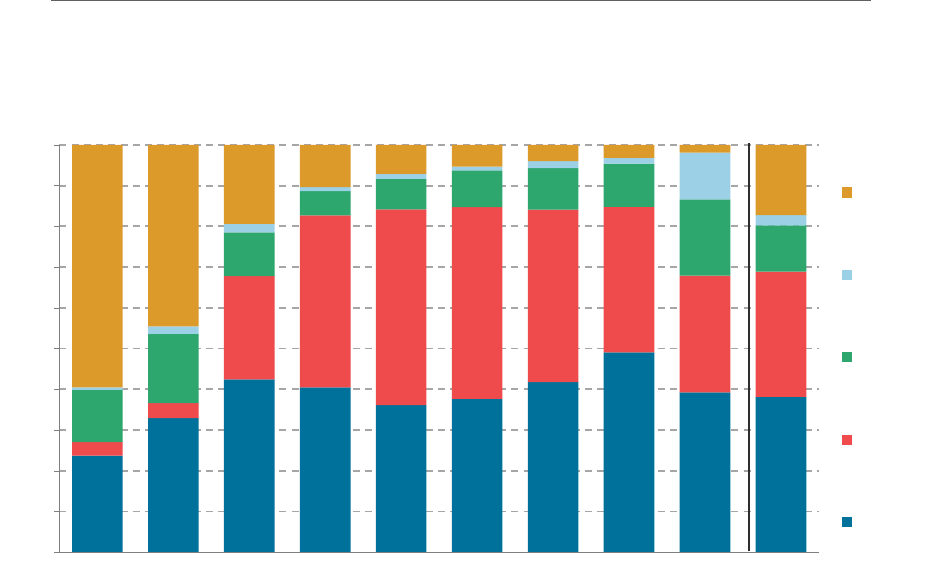
14
There is significant heterogeneity in the types of assets held by families across the
wealth distribution (see Figure 4). Poorer families tend to have very little gross property
or financial wealth and are more likely to have financial debts exceeding assets than
a typical family – this means that physical assets make up a much higher proportion
of their overall wealth. This pattern reverses for wealthier families: net property wealth
is the most important source of wealth for the fifth, sixth, seventh and eighth deciles,
while physical assets make up a very small share of the total wealth for the richest
families. Pension assets make up the largest source of net wealth of all asset types and
is remarkably stable across the wealth distribution at the fourth decile and above. Poorer
households are much less likely to have private pension wealth, likely reflecting lower
capacity to save for retirement due to low income, although there is some evidence that
in recent years more families across the wealth distribution now have access to defined
contribution pension wealth as a result of auto-enrolment (Slaughter, 2020).
FIGURE 4: Business assets are much more prevalent at the top of the wealth
distribution
Average share of total net wealth contributed from different asset classes by family net
wealth decile: GB, 2016–2018
NOTES: Individuals are allocated to deciles based on wealth measured at family level. The lowest decile is
excluded as net wealth is negative. Property wealth here is measured net of mortgage debt and financial
wealth is net of other financial liabilities. Figure C3 shows this graph using households as the unit of
analysis. Figure D3 shows the average share of total net wealth contributed from different asset classes
when main homes and pension wealth are excluded.
SOURCE: ONS, Wealth and Assets Survey.
24%
33%
42%
40%
36%
38%
42%
49%
39%
38%
3%
4%
25%
42%
48%
47%
42%
36%
29%
31%
13%
17%
11%
6%
7%
9%
10%
11%
19%
11%
60%
45%
19%
10%
17%
0%
10%
20%
30%
40%
50%
60%
70%
80%
90%
100%
2 3 4 5 6 7 8 9 10 Average
Physical
Business
Financial
Property
Pension
The UK’s wealth distribution and characteristics of high-wealth households |
Resolution Foundation
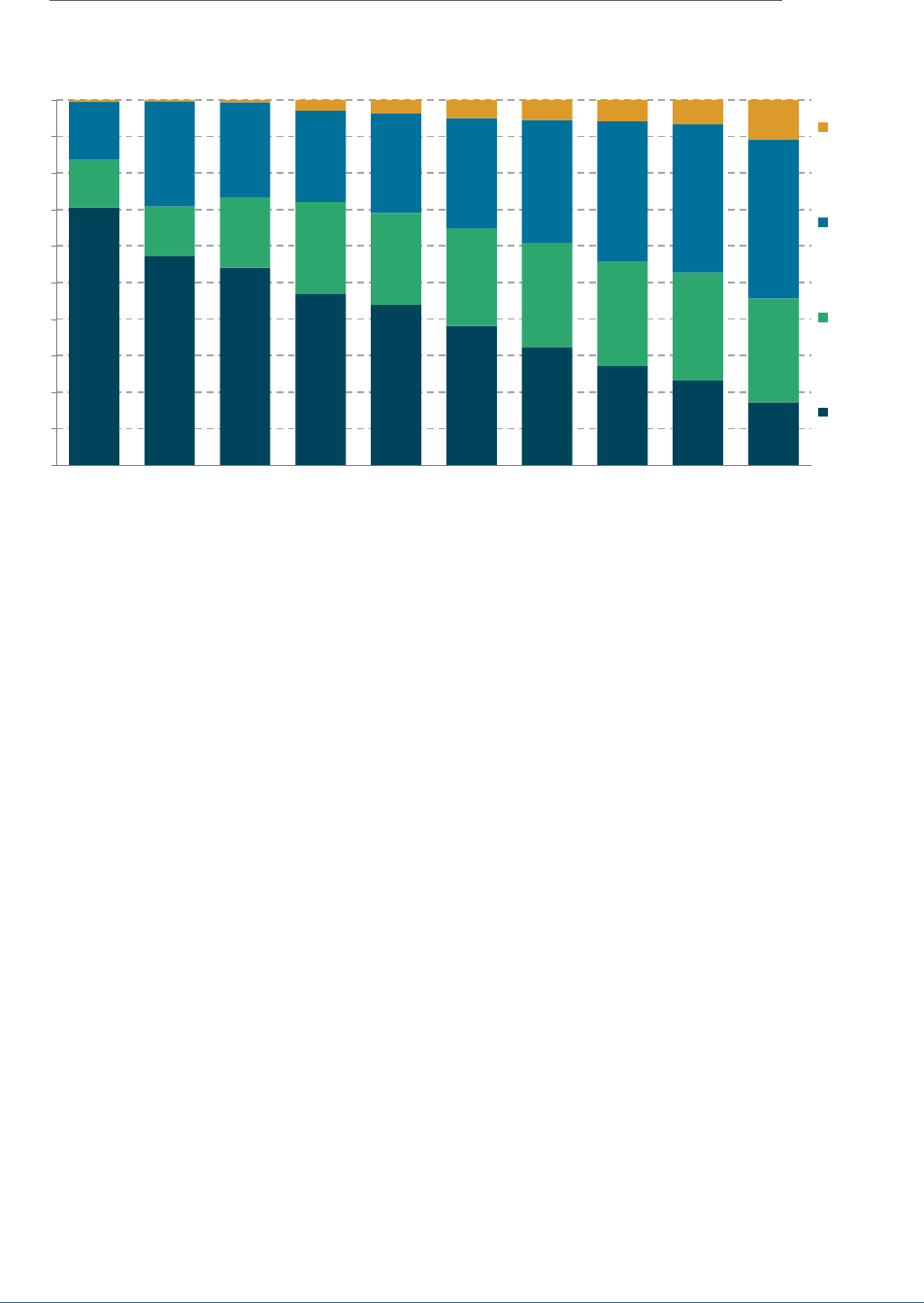
15
FIGURE 5: Wealthier families hold more higher-returning riskier assets
Composition of financial assets by family net wealth decile: GB 2016–2018
NOTES: Individuals are allocated to deciles based on total wealth measured at family level. Zero-return
assets include cash, current accounts and other informal financial assets. Savings assets include savings
accounts (i.e. interest-bearing sight deposit accounts) and national savings products. Safe assets include
ISA accounts,18 saving bonds (i.e. fixed term saving accounts), unit and investment trusts, insurance
products and other formal financial assets. Risky assets include domestic and overseas shares and bonds.
Figure B4 shows this graph using individuals as the unit of analysis.
SOURCE: ONS, Wealth and Assets Survey.
Changes in wealth levels
Financial Wealth
A hugely important trend for financial wealth has been the scale of the aggregate
increase in its value; since 2006–08 total financial wealth in Great Britain has increased
by more than 60% in real terms (from £1.4 trillion to £2.3 trillion) in current CPI-adjusted
prices. This represents a remarkable increase in the wealth families hold. Bangham and
Leslie (2020) and Mulheirn (2020) show that the increase in financial wealth over this
period has been overwhelmingly driven by changes in asset prices rather than active
saving by individuals.
Figure 6 shows the estimated share of families’ change in financial wealth as a result of
changes in financial asset prices and financial market yields. This analysis exploits the
longitudinal nature of the WAS. Concretely, the change in financial wealth of each family
is calculated for each adjacent two-year period of the survey. A counterfactual financial
wealth value is calculated by applying the average returns observed for a granular
18 This includes both cash ISAs (which would be more similar to savings assets in this taxonomy) and stocks and shares ISAs. We
have included both within the ‘safe assets’ group because both these ISA accounts would typically have a higher yield than non-
ISA savings accounts.
71%
57%
54%
47%
44%
38%
32%
27%
23%
17%
13%
14%
19%
25%
25%
27%
29%
29%
30%
28%
16%
29%
26%
25%
27%
30%
34%
38%
41%
43%
4%
5%
6%
6%
7%
11%
0%
10%
20%
30%
40%
50%
60%
70%
80%
90%
100%
1
(lowest)
2 3 4 5 6 7 8 9 10
(highest)
Risky
assets
Safe assets
Savings
assets
Zero-return
assets
The UK’s wealth distribution and characteristics of high-wealth households |
Resolution Foundation
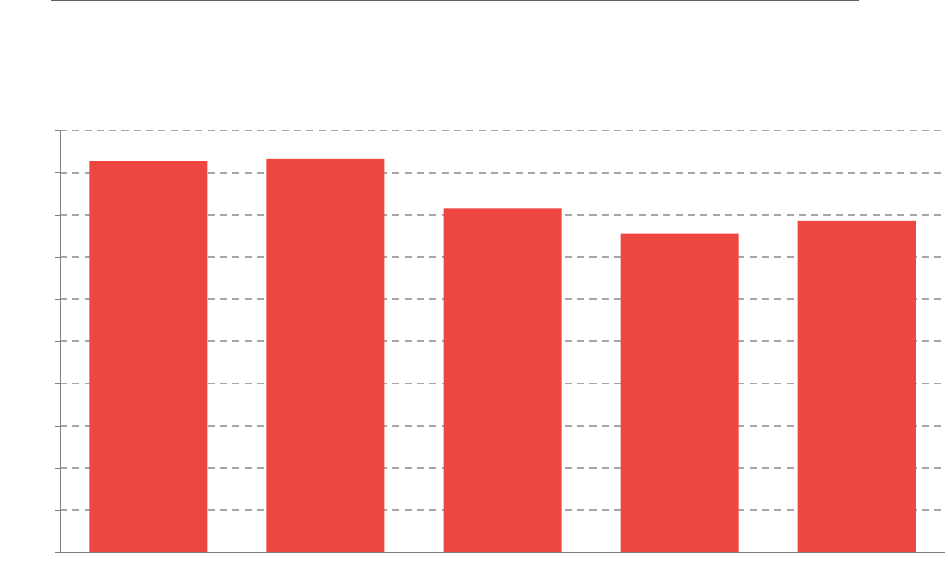
16
breakdown in financial asset classes over the relevant two-year period. Between 2008–10
to 2010–12, for example, 93% of the average change in families’ financial wealth could be
accounted for by changing asset prices and financial market yields. The remaining wealth
change is the net saving of the family over this period.
This fact is important context for understanding how wealth has changed in the UK: to a
large extent, wealth gains for families have accrued as a result of already holding wealth –
wealth gains have been passive rather than requiring active saving. This also is important
for any government considering the taxation of wealth as people are likely to feel it is
more justifiable for a government to tax ‘unearned’ gains in wealth rather than those
which come about through ‘virtuous’ action like working more or saving (Sachweh and
Eicher, 2020; Rowlingson, Sood and Tu, 2020).
FIGURE 6: Almost all the gains in financial wealth since 2006-08 have come
from changes in asset prices rather than saving
Share of total average gains in financial wealth from changes in asset prices: GB
NOTES: Total changes in family financial wealth is measured between each two-year sample of the WAS.
This is compared to a counterfactual change in wealth predicted by average financial returns for a granular
breakdown of assets. This is then used to calculate the share of the observed change in wealth that would
on average have resulted from financial returns.
SOURCE: Bangham and Leslie (2020).
Increasing financial wealth has also tended to accrue to the already wealthy. As already
shown, wealthier households tend to hold financial assets which have more risk but also
tend to have higher average returns. In simple terms, a household holding a portfolio of
company shares will have experienced a larger increase in wealth than one who held
the same wealth in a savings account which in turn had a higher return than cash (see
93%
93%
82%
76%
79%
0%
10%
20%
30%
40%
50%
60%
70%
80%
90%
100%
2008-10 2010-12 2012-14 2014-16 2016-18
The UK’s wealth distribution and characteristics of high-wealth households |
Resolution Foundation
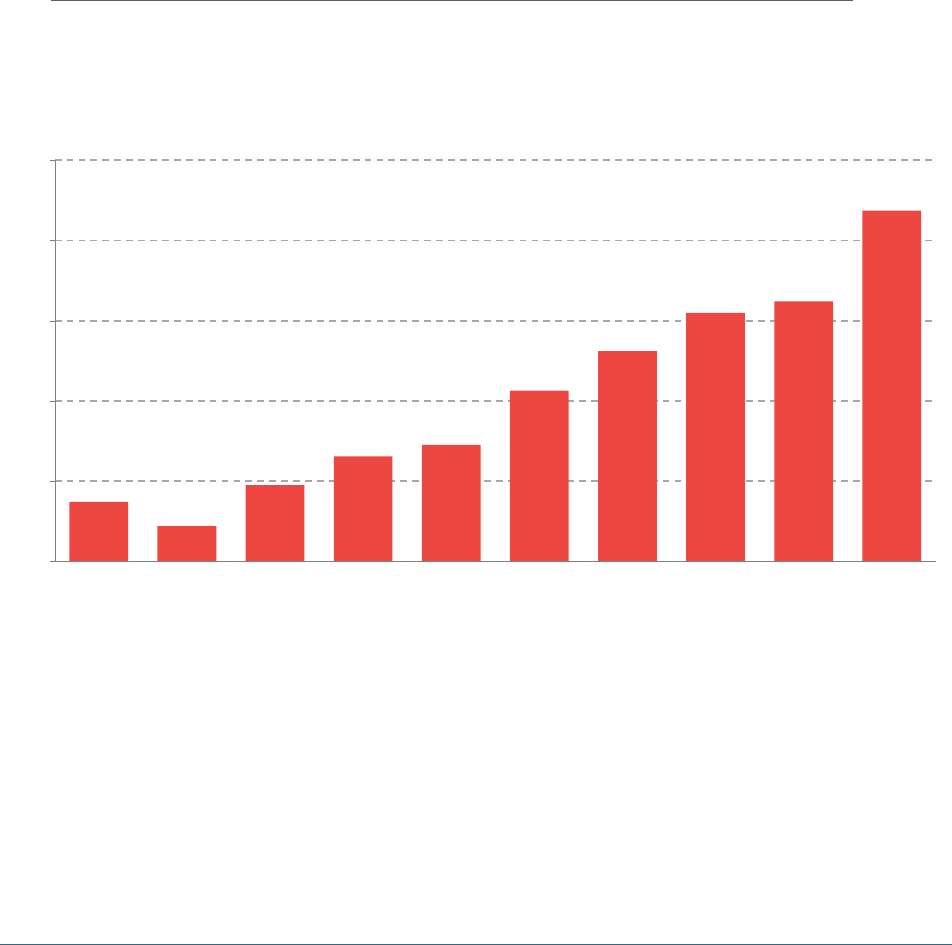
17
also Bach, Calvet and Sodini, 2020; Fagereng et al., 2020). Figure 7 presents a crude
estimate of this in-built acceleration of wealth inequality whereby richer households will
tend to experience faster gains in wealth. This estimate is calculated as the weighted
average return for the average financial portfolio for a family within each decile based on
granular financial asset classes. This is not an estimate of the actual return experienced
by families because real returns will diverge from the average, and this divergence may
differ across the wealth distribution.
19
Saez and Zucman (2016) argue that divergences
in returns across the wealth distribution has been one of the most important drivers in
rising wealth inequality in the US over the past few decades.
FIGURE 7: Wealthier families tend to experience higher financial returns to
their assets
Mean annual financial asset return based on differences in portfolio composition, by
family net wealth decile: GB, 2016–2018
NOTES: A family’s financial return is calculated as an average of the observed average annual financial
returns for a granular set of financial assets weighted by their financial asset portfolio composition. Each
family’s calculated financial return is average within net family total wealth deciles. This does not show the
actual returns experienced by each family as this is not observed in the WAS data.
SOURCE: Bangham and Leslie (2020).
Pension Wealth
Financial wealth is not the only category of wealth which has experienced increases
in value over the past decade. Aggregate private pension wealth has also increased
in value by more than 60% since 2006–2008 (ONS, 2019a). In practice, the drivers of
19 Indeed, Fagereng et al. (2019) show that richer households in Norway tended to achieve higher than average returns within asset
classes. Similarly, Bach, Calvet and Sodini (2020), show that returns on wealth are highly persistent and are positively related to
existing wealth levels. The estimates presented here are therefore likely to be an underestimate of the divergence between richer
and poorer families.
0.4%
0.2%
0.5%
0.7%
0.7%
1.1%
1.3%
1.5%
1.6%
2.2%
0.0%
0.5%
1.0%
1.5%
2.0%
2.5%
1
(lowest)
2 3 4 5 6 7 8 9 10
(highest)
The UK’s wealth distribution and characteristics of high-wealth households |
Resolution Foundation

18
increased pension wealth are similar to those affecting financial wealth because
the majority of assets underlying the value of pension funds are financial assets. In
particular, the secular decline in interest rates around the world as central banks cut
rates and conducted quantitative easing to counteract the post-financial crisis economic
slowdown, has lifted the price of financial assets around the world.
20
An important
difference between financial wealth and pension wealth is that rises in pension wealth
levels have a lower impact on relative inequality because pension wealth is held more
equally across the wealth distribution.
Property Wealth
Property wealth gains have been much lower over the past decade, rising by just 14% in
real terms. While interest rates falls push up property prices all else equal, and explain a
large part of the rise in property values (Mulheirn, 2019; 2020; Miles and Monro, 2019), falls
in mortgage rates have tended to be smaller than the falls central bank rates. Outside the
South of England, real house prices have been largely flat since the pre-financial crisis
peaks, limiting the gains that many families have experienced in property wealth. The
relatively slow growth in property wealth is a major driver of the declining share of wealth
in the middle of the distribution, as property wealth makes up a much larger share of
wealth for middle-wealth families (Figure 4).
Demography
As we have shown, the major driver of the changing size and distribution of wealth
has been the returns to financial and pension wealth and the (relative) lack of returns
to property wealth over the past decade. But there is another potentially important
factor: demographic changes – particularly the ageing population. An individual’s wealth
changes substantially over the course of their life, with families tending to build up
wealth over working age before drawing down wealth somewhat in retirement (D’Arcy
and Gardiner, 2017). The UK population has been ageing and is expected to continue to
do so; between 2006 and 2019 the share of the population between 20 and 39 years old
fell from 27.3% to 26.3% and is expected to fall to 24.5% by 2040 (ONS, 2019b). There has
been a commensurate increase in older workers and retired people. This would naturally
lead to a shift in the distribution of wealth however, as shown in Figure 8, the estimated
effect of the ageing population has been small relative to the scale of the overall shift in
wealth shares across the wealth distribution.
20 See Gangon et al. (2019) for more detail on the impact of quantitative easing on wealth inequality in the UK.
The UK’s wealth distribution and characteristics of high-wealth households |
Resolution Foundation

19
FIGURE 8: The impact of population has been relatively small
Estimated change in share of wealth for each net family wealth decile due to population
ageing: GB
NOTES: These estimates are calculated by reweighting the WAS sample from 2006–2008 to match the
2019 age distribution and the 2016–2018 WAS sample to match the 2040 projected age distribution. This
estimate therefore abstracts from cohort effects.
SOURCE: ONS, Wealth and Assets survey; ONS population estimates.
Characteristics of high-wealth households
Much of the political focus on inequality in the UK and around the world focusses
on the people who are at the top of the distribution. This section tries to explore the
characteristics of families which could be considered high-wealth. As high-wealth is
a subjective term, we use five thresholds as markers of high wealth families: families
where the per adult net wealth exceeds £250,000, £500,000, £1 million, £2 million and £5
million. These thresholds broadly range from households in the top 40% of the wealth
distribution to the top 1%. In practice, this analysis is also useful for understanding the
characteristics of families which may be subject to plausible thresholds for a net wealth
tax. As such we might also be interested in the characteristics of those with wealth
above these thresholds for a more restrictive definition of wealth that could be adopted
for a wealth tax; Appendix E reproduces the results below where total wealth is defined to
exclude wealth from main residential properties and pensions.
Demographic characteristics
There are large differences in the probability of an individual living in a high wealth
family across age and sex (Figure 9a and b). There is a clear tendency for older people
to live in high wealth families. This is unsurprising given the strong life-cycle effects
in wealth but will also partially reflect cohort effects whereby older generations were
-0.04ppts
-0.02ppts
0.00ppts
+0.02ppts
+0.04ppts
+0.06ppts
+0.08ppts
1 2 3 4 5 6 7 8 9 10
2006-2019
2019-2040
The UK’s wealth distribution and characteristics of high-wealth households |
Resolution Foundation

20
able to accumulate wealth at a faster rate than younger generations. Men are also
more likely than women to live in high-wealth families, largely reflecting the fact that
single men are more likely to be high wealth than single women. The biggest disparity
in high-wealth families by age is for those with per-adult wealth above £2 million, where
families are much more likely to be late working age or early retirement. However, the
pattern switches at a threshold of £5 million to having much less variation by age. This is
consistent with the lifecycle consumption-smoothing motivation for savings being a less
important driver of wealth accumulation and decumulation at this high level of wealth.
Figure 9a: Older people are much more likely to have high wealth
Share of age and sex group that live in high-wealth families (above £250,000 per adult):
GB 2016–2018
NOTES: Wealth thresholds are measured as total wealth per adult within the family. Figure E1 shows this
graph using an alternative definition of wealth that excludes main homes and pension wealth.
SOURCE: ONS, Wealth and Assets Survey.
0%
10%
20%
30%
40%
50%
60%
70%
Male
Male
Male
Male
Male
Male
Male
Male
Male
Male
Male
Male
Male
Female
Female
Female
Female
Female
Female
Female
Female
Female
Female
Female
Female
Female
20-
24
25-
29
30-
34
35-
39
40-
44
45-
49
50-
54
55-
59
60-
64
65-
69
70-
74
75-
79
80+ 20-
24
25-
29
30-
34
35-
39
40-
44
45-
49
50-
54
55-
59
60-
64
65-
69
70-
74
75-
79
80+
£250k £500k £1m
The UK’s wealth distribution and characteristics of high-wealth households |
Resolution Foundation
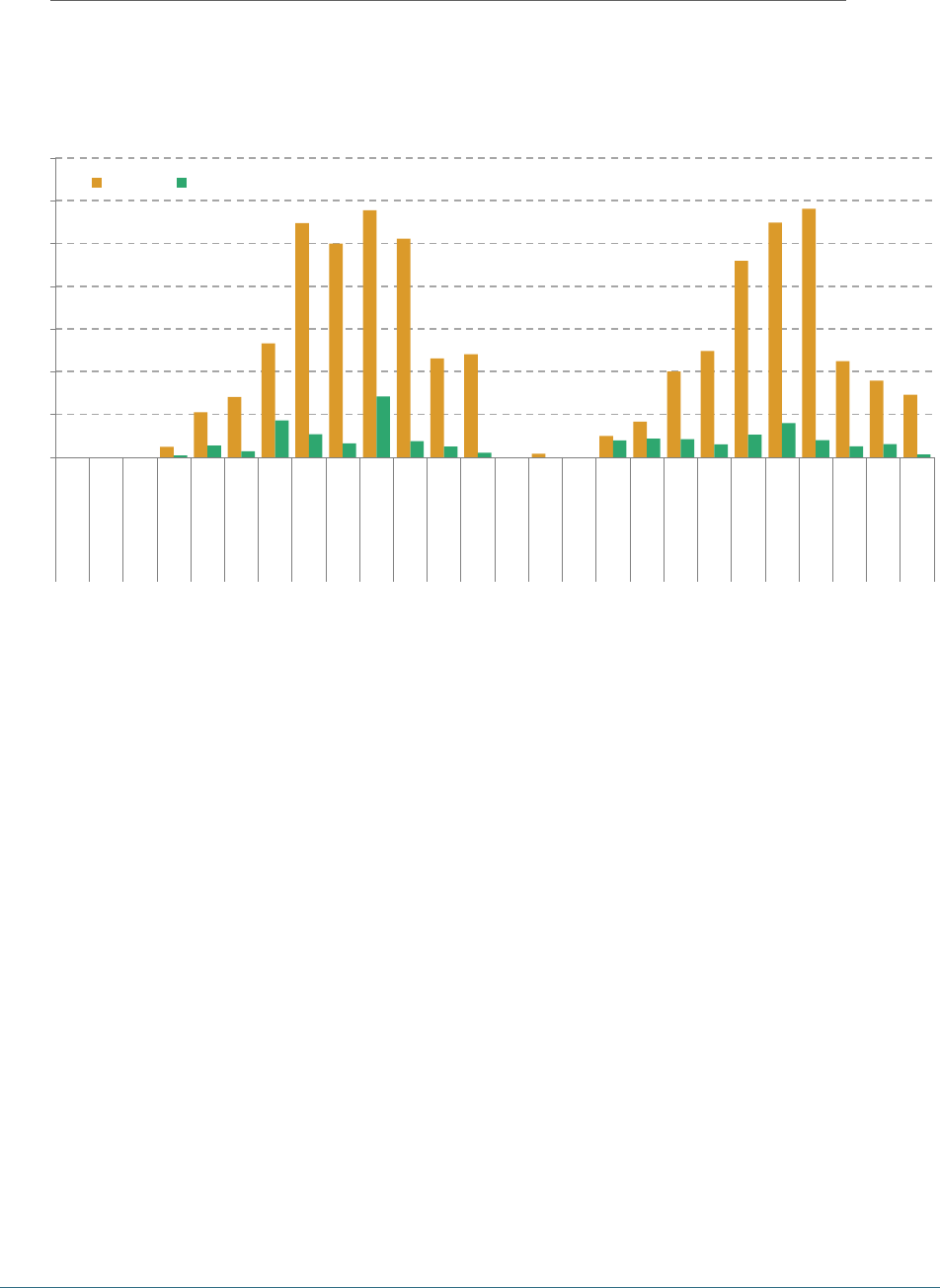
21
Figure 9b: The very wealthiest families are more evenly spread over the age
distribution
Share of age and sex group that live in high-wealth families (above £2 million per adult):
GB 2016–2018
NOTES: Wealth thresholds are measured as total wealth per adult within the family. Figure E2 shows this
graph using an alternative definition of wealth that excludes main homes and pension wealth.
SOURCE: ONS, Wealth and Assets Survey.
Additionally, the variation in wealth holdings between households of different ethnicities
is striking, and is under-studied due to the scarcity of relevant data. Figure 10 shows the
proportion of households with total net wealth above £250,000 and above £500,000.
21
It shows that households whose Household Reference Person is of White ethnicity are
most likely to have total net wealth of £500,000 or more, closely followed by those of
Indian ethnicity.
22
The sample size precludes us from examining all of the ethnic minority
groups available in the data individually, but Figure 10 can tell us that households of Black
African ethnicity are least likely to have net wealth over the £500,000 threshold, and four
times less likely than those of White ethnicity.
21 Sample sizes become too small to present results for higher wealth thresholds. It is also important to note that this is a different
unit of analysis from the other charts in this section, as a result of needing to use a more data-secure version of the WAS dataset
to conduct analysis by ethnicity.
22 Ethnic group is based on the Household Reference Person’s reported ethnicity – this is the survey-designated primary adult within
the household. Where the individuals within a couple have different ethnicities, this will not be captured by our estimates.
0.0%
0.5%
1.0%
1.5%
2.0%
2.5%
3.0%
3.5%
Male
Male
Male
Male
Male
Male
Male
Male
Male
Male
Male
Male
Male
Female
Female
Female
Female
Female
Female
Female
Female
Female
Female
Female
Female
Female
20-
24
25-
29
30-
34
35-
39
40-
44
45-
49
50-
54
55-
59
60-
64
65-
69
70-
74
75-
79
80+ 20-
24
25-
29
30-
34
35-
39
40-
44
45-
49
50-
54
55-
59
60-
64
65-
69
70-
74
75-
79
80+
£2m £5m
The UK’s wealth distribution and characteristics of high-wealth households |
Resolution Foundation
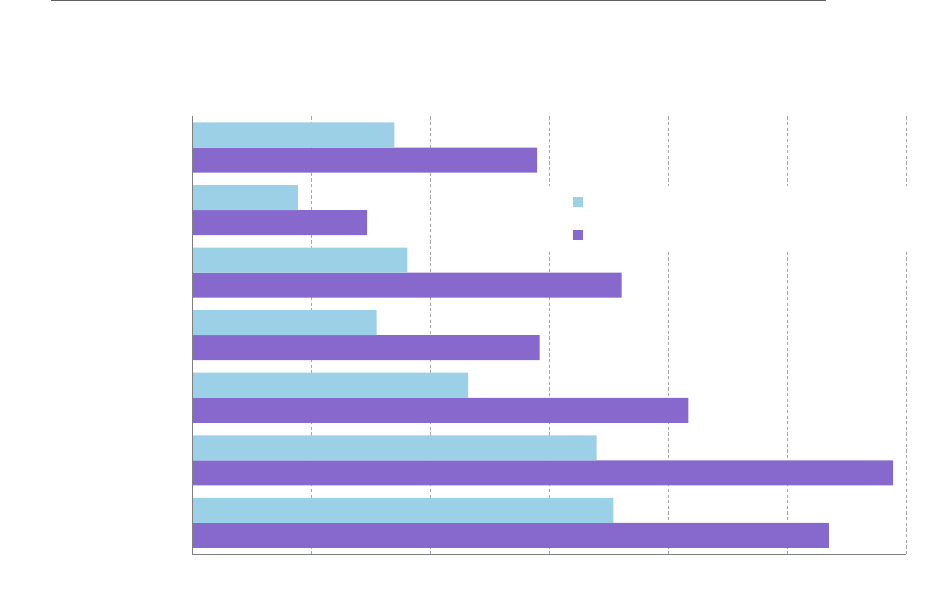
22
FIGURE 10: White and Indian families are more likely to have high wealth
Share of households above wealth thresholds within ethnicity groups, by ethnicity of
Household Reference Person
NOTES: Wealth thresholds are measured as total wealth per adult within the family. Individuals reporting
Chinese, Mixed and Other ethnicities are combined due to restrictions on the minimum sample size that
can be analysed.
SOURCE: Office for National Statistics, Social Survey Division. (2020). Wealth and Assets Survey, Waves 1-5
and Rounds 5-6, 2006-2018: Secure Access. [data collection]. 6th Edition. UK Data Service. SN: 6709. DOI:
http://doi.org/10.5255/UKDA-SN-6709-5
Geography
Another characteristic of interest is the geographic distribution of high wealth families.
As Figure 11 shows, the South East of England has the highest number of high-wealth
families, with well over 3 million adults living in families with net wealth per adult over
£250,000. The North East is the region with the lowest proportion of high-wealth families.
Figure 12 shows the share of the total number of families which are above the wealth
threshold coming from each region. This shows that the large regional disparity in high-
wealth families magnifies as the threshold increases. For example, 14% of all families with
per-adult wealth above £250,000 are in London but this share rises to 24% for families
with wealth above £2 million.
54%
59%
42%
29%
36%
15%
29%
35%
34%
23%
16%
18%
9%
17%
0% 10% 20% 30% 40% 50% 60%
White
Asian - Indian
Asian - Pakistani
Asian - other
Black Caribbean
Black African
Mixed, Chinese, other
Proportion with wealth of £500k or more
Proportion with wealth of £250k or more
The UK’s wealth distribution and characteristics of high-wealth households |
Resolution Foundation
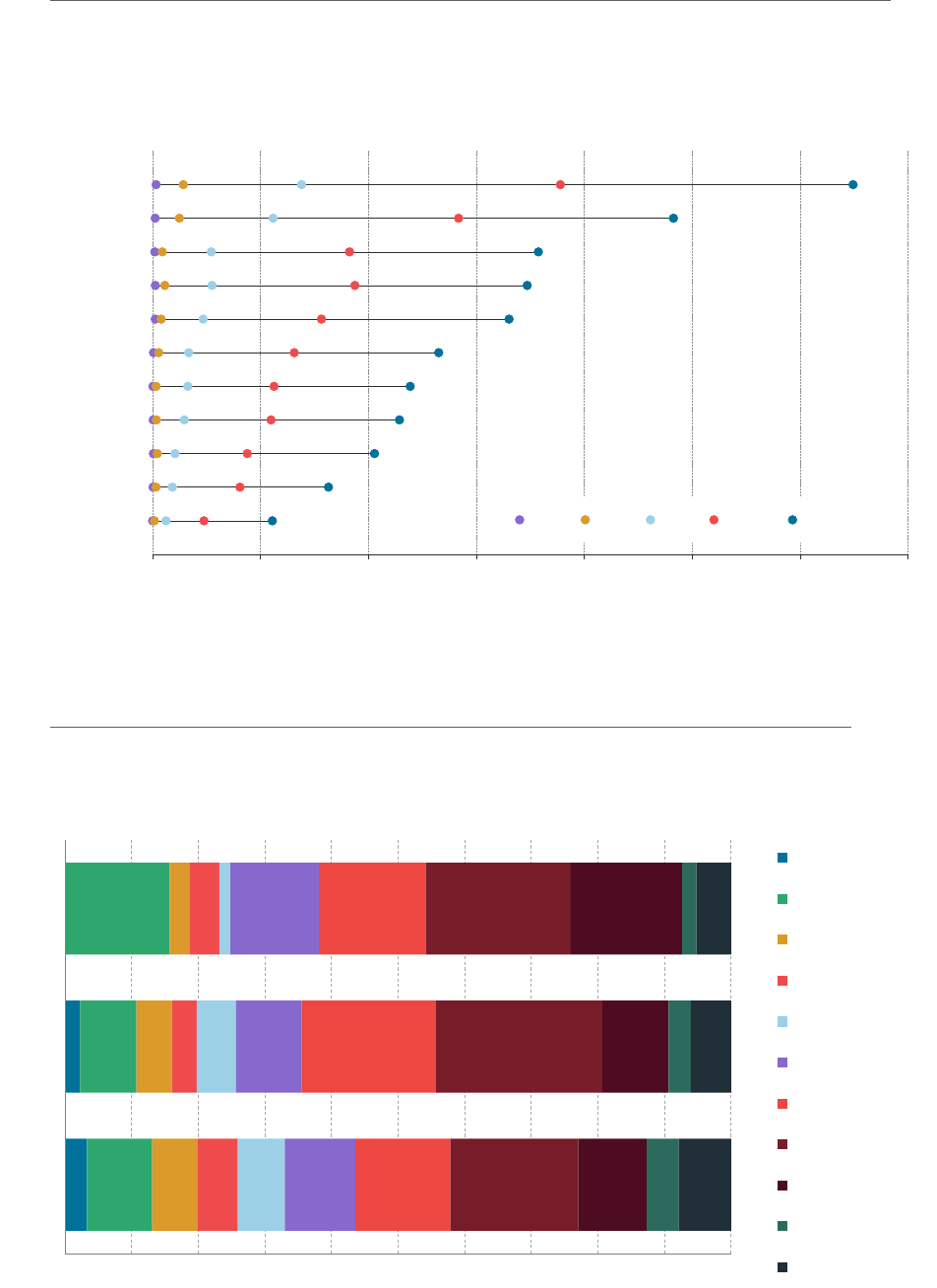
23
FIGURE 11: The South and East of England have the highest numbers of wealthy
families
Number of high-wealth individuals by threshold level, calculated at the family level: GB,
2016–2018
NOTES: Wealth thresholds are measured as total wealth per adult within the family. Figure E3 shows this
graph using an alternative measure of wealth which excludes main homes and pension wealth.
SOURCE: ONS, Wealth and Assets Survey.
FIGURE 12: London and the South East of England have the highest share of
wealthy families
Share of all families above wealth threshold by region: GB 2016–2018
NOTES: Wealth thresholds are measured as total wealth per adult within the family. Figure E4 shows this
graph using an alternative measure of wealth which excludes main homes and pension wealth.
SOURCE: ONS, Wealth and Assets Survey.
South East
London
East of England
South West
North West
Scotland
West Midlands
Yorkshire
East Midlands
Wales
North East
0 0.5m 1.0m 1.5m 2.0m 2.5m 3.0m 3.5m
£5m £2m £1m £500k £250k
0% 10% 20% 30% 40% 50% 60% 70% 80% 90% 100%
£250k
£1m
£5m
North East
North West
Yorkshire
East Midlands
West Midlands
East of England
London
South East
South West
Wales
Scotland
The UK’s wealth distribution and characteristics of high-wealth households |
Resolution Foundation
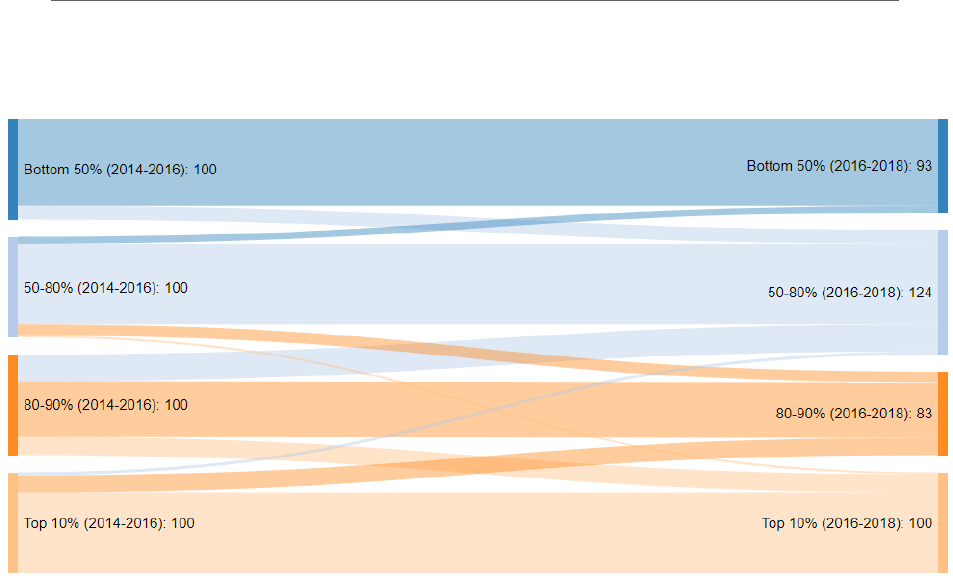
24
Volatility
A natural question is how stable the group of high wealth families is over time. In other
words, how frequently does a high wealth family become a lower wealth family or vice
versa. As Figure 13 shows, there is relatively little churn between families lower in the
wealth distribution just 7% of families in the bottom half of the wealth distribution move
into the top half over a two-year period. We look at this relatively short time period
because it best represents the possible regular change in the population of families
covered by a wealth tax that we might expect. Viewing the movement of families
across the wealth distribution over a longer time period results would result in higher
mobility, largely reflecting life-cycle effects (as highlighted by Figures 9a and b) and
intergenerational transfers (which are only partially covered by the WAS, making further
analysis beyond the scope of this paper) rather than movements due to volatility in
wealth holdings. However, there is more churn in wealth in the upper-middle of the
wealth distribution where a much higher proportion of those in the ninth decile move
up or down the wealth distribution, over the relatively short two-year period, than in the
lower half of the wealth distribution.
FIGURE 13: Movement along the wealth distribution is small over short periods
of time
Proportion of families moving between wealth groups over two years
NOTES: Observations for families who appear in both the 2014–2016 and 2016–2018 WAS samples are
linked between the two samples. Their position in the wealth distribution is recorded in both and the
share of households moving between groups is shown. The sample is weighted to account for differential
sample attrition based on a probit model including observed characteristics including family type, age and
education.
SOURCE: ONS, Wealth and Assets Survey.
The UK’s wealth distribution and characteristics of high-wealth households |
Resolution Foundation

25
Asset composition
Unsurprisingly, there are big differences in the types of assets held by the average family
above each wealth threshold. Figure 14 shows the average share of total assets from each
broad asset class for families above each wealth threshold. There is a big step-change
between families above £2 million per-adult wealth and £5 million where the relative
importance of business and financial assets is much higher for the very wealthiest
families. This has important implications for policymakers considering implementing a
wealth tax; if the wealth tax threshold is set at a low level, the biggest sources of revenue
would be property wealth and pension wealth (excluding these asset-types would reduce
the tax base by 80%), in contrast, under a very high wealth tax threshold, financial and
business wealth would be the most important assets for the tax base.
FIGURE 14: The very wealthiest families hold much more financial and business
wealth than other wealthy families
Composition of net wealth by groups captured by each threshold: GB, 2016–2018
NOTES: Wealth is measured at the family level – single or couple adults and any dependent children within
a household. Total wealth includes net financial assets, net property assets, pension assets, business
assets and an adjusted measure of physical wealth (including cars, home contents, collectibles, etc). Figure
E5 shows this graph using an alternative measure of wealth which excludes main homes and pension
wealth.
SOURCE: ONS, Wealth and Assets Survey.
0%
10%
20%
30%
40%
50%
60%
70%
80%
90%
100%
£250k £500k £1m £2m £5m
Physical
Business
Financial
Property
Pension
The UK’s wealth distribution and characteristics of high-wealth households |
Resolution Foundation

26
Adjusting for data deficiencies
Adjusting for high wealth families
One of the major challenges with understanding the size and distribution of wealth,
particularly in any country without a wealth tax (and so comprehensive administrative
wealth data), is deficiencies in the data. Aggregate wealth measured in WAS using our
preferred definition is £14.4 trillion, but this is likely to be an under-estimate of true wealth
in the UK.
23
There are good reasons to think that wealthier households are less likely to
respond to surveys such as the WAS. For example, wealthier households will tend to have
more complicated set of assets and liabilities, making responding to the survey more
time consuming and difficult. The incentive payments offered to engage in the survey will
also be relatively less valuable to these households.
24
Item non-response where survey
respondents fail to include some of their assets is also a source of concern. The reasons
leading to lower high-wealth response rates will tend to magnify the higher up the wealth
distribution a family lies. This means there is a greater chance that the very wealthiest
people in the UK will not be captured by the sample leading to a significant gap in the
estimated total UK wealth and how much of wealth is held at the top of the wealth
distribution.
In order to explore the size of the potential under-coverage of high-wealth in the WAS,
we turn to the best available summary of the wealthiest families in the UK – the Sunday
Times Rich List (STRL). This is an annual publication which attempts to identify the 1,000
richest families that predominately live or work in the UK (we turn to the issues of primary
address, citizenship and tax residency location later). The data is compiled in such a way
so as to represent a plausible lower-bound estimate of each family’s wealth (Watts, 2020)
– and amounts to a total wealth value of £700billion. The STRL takes a cautious approach
to valuing wealth in a number of ways. First, not all assets are included – data is primarily
based on private and public business assets as well as known land holdings and other
items (such as art holdings). Private financial assets (excluding shares) will largely not
be captured as there is no available data in order to base their wealth estimates. Given
the composition of assets highlighted for the wealthiest observations in the WAS, this
suggests that there could be significant additional wealth not captured by the STRL.
There is also some risk that individuals who keep their wealth private, by holding wealth
via trusts for example, may be excluded from the list. Second, for private businesses with
high debts, the authors remove the owners from the STRL even if they may have high
enough wealth to be included. A third issue is that private businesses are valued at a
23 The official estimate of total wealth in the UK produced by the ONS is £14.6 trillion, but they use a different definition which
excludes business wealth and uses the full replacement cost for physical wealth (rather than our estimated current value based on
taking 25% of the replacement cost).
24 The ONS provide an ‘incentive’ payment of between £10 and £15 worth of vouchers for each survey.
The UK’s wealth distribution and characteristics of high-wealth households |
Resolution Foundation

27
relatively low multiple of earnings (10 to 12 times recent earnings compared to 20 times
for FTSE 250 companies).
Combining the two datasets we see that the WAS sample overlaps with the STRL; the
WAS includes observations for two households with wealth above £100 million.
25
This
suggests that the WAS is managing to sample some households at the very top of the
UK’s wealth distribution. In fact, when accounting for the weighting of households in the
WAS which overlap with the STRL, it appears that the WAS roughly captures the correct
number of households above the minimum threshold to be in the STRL.
Despite the coverage of high-wealth families in the WAS, it is likely that it is not
fully capturing total household wealth in the UK. This is because the very wealthy
observations in the WAS are not fully representative of the wealth of those captured by
the STRL. Indeed, the weighted total wealth of these two top households is just under
£300 billion, compared to £700billion in the STRL. This implies that at a minimum, the
WAS underestimates wealth at the top by £400billion. This is because the very wealthy
observations in the WAS are not fully representative of the wealth of those captured by
the STRL: given the wide range of wealth values in the STRL, the WAS observations that
do overlap with the top have wealth levels far below the top of the STRL. In addition, it is
likely the wealthiest families have large variations in the composition of their assets: the
WAS observations may not be a ‘typical’ top-wealth family.
Pareto distribution
Approach
The analysis presented so far is only indicative of the size of the potential missing
wealth; in order to fully estimate the value of missing wealth we implement a similar
approach taken by Vermeulen (2018) and Bach, Thiemann and Zucco (2019). The basic
idea underlying this approach is as follows. Suppose we know something about the
behaviour of the true wealth distribution at the top, but not its exact shape. The observed
distribution of wealth departs from the true distribution because of under-coverage of
wealth in the survey data. However, using information contained in the Sunday Times
Rich List, we can combine this with what we understand about the behaviour of the
wealth distribution to update our estimate of its exact shape.
Concretely, we assume that the top tail of the wealth distribution matches a Pareto
distribution, which means that the proportion of households with wealth above a certain
25
The most recent version of the publicly available version of the WAS microdata censors some observations to ensure that the data
does not disclose details about individual families.
The UK’s wealth distribution and characteristics of high-wealth households |
Resolution Foundation

28
threshold will be proportional to that threshold raised to a power.
26
This property defines
the ‘behaviour’ we expect the true wealth distribution to abide by. According to this
property, as you consider higher and higher wealth levels, the frequency of households
declines – and does so at a pace defined by the shape of the Pareto distribution. If
there is substantial under-coverage at the top in the survey data, then as we move up
the observed wealth distribution, the frequency of households will decline faster than
it should according to the Pareto distribution. However, we can use information on the
wealth of households in the Sunday Times Rich List to get a more accurate estimate of
the specific rate at which the frequency of households should decline, and hence the
shape of the overall distribution. There is a long history of empirical evidence which
suggests that wealth holdings follow a Pareto distribution (for example, Klass et al., 2006).
We estimate the specific shape of the Pareto distribution by pooling the data from the
WAS and the STRL, and estimate the distribution over this combined sample.
27
An important difficulty in taking this approach is that it assumes that the WAS sample
and STRL have a common underlying definition of wealth, and a consistent measure
of ‘units’ who hold the wealth. However, we know that is not the case. First, the asset
classes covered are different: the WAS data is a comprehensive account of all assets
and liabilities while the STRL is primarily based on business assets with some additional
assets added where available. Second, the STRL observations are taken at a broad family
level, and this often includes more than two adults and their dependent children (the
definition of family used previously). For example, in the 2020 list, the Barclay brothers
are listed jointly at 17th but were they to be part of the WAS survey, they would be treated
as separate households. In order to account for the first issue, we create a measure of
wealth in the WAS which most closely relates to the coverage of assets in the STRL –
specifically, we combine private business assets with domestic and foreign shares as well
as non-savings bonds, which are included in financial wealth in the WAS. This approach
will be imperfect because the publicly available information upon which the STRL is
based will not capture this exact definition of wealth for all observations; Appendix F
provides results based on alternative definitions of wealth as a robustness check. For
the second issue, we use WAS data at the household level (rather than at the family level
as with previous analysis), while there is relatively little empirical difference between the
data aggregated at a family and household level (particularly at the top of the distribution
26 Hence the Pareto distribution is also known as a power-law probability distribution. See Jones (2015) for a full explanation of the
mathematical form of the Pareto distribution and its relationship to the wealth distribution. Adapting his notation, the Pareto
distribution says that the fraction of wealth held by the top p percentiles is equal to 100pwhere the parameter sets the shape of
the distribution (or, in other words, the fatness of the tail); if =-0.5, the top percentile of the wealth distribution would have 10% of
total wealth while the top 2 percent of household would have just over 14% of total wealth.
27 For the estimation we follow the approach set out in Vermeulen (2018) for a finite sample with survey weights, as the WAS
observations have survey weights from the ONS and we assume that the STRL observations each represent an individual family.
Households are ranked by their wealth, from highest to lowest, so that for each observation we have a value for the proportion
of the sample which have wealth above a given threshold – in other words the dependent variable needed for estimating the
distribution parameter. We estimate the Pareto distribution using ordinary least squares (OLS) after adjusting the dependant
variable for sample weights and bias in log-log rank-size estimates, as suggested by Gabaix and Ibragimov (2012).
The UK’s wealth distribution and characteristics of high-wealth households |
Resolution Foundation
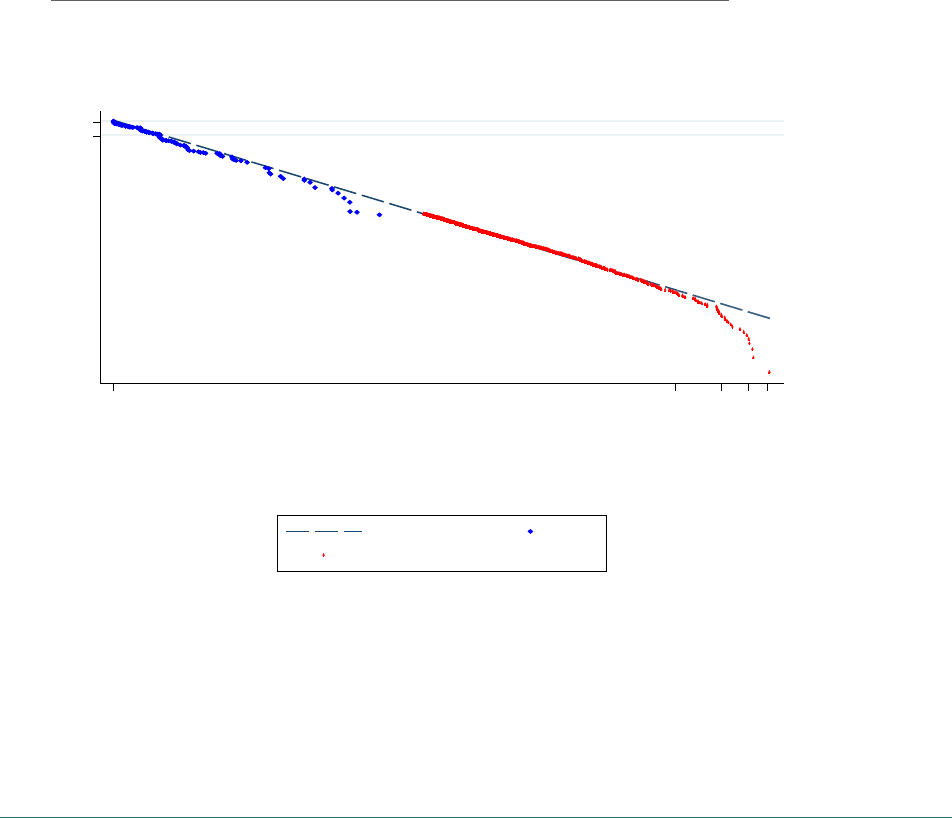
29
where households are less likely to include multiple adults outside of couples), the
maximal definition of the unit of analysis used by the STRL will be best approximated,
albeit imperfectly, with household data from the WAS.
Estimated ‘missing’ wealth
Figure 15 shows the fitted Pareto distribution using our definition of business wealth from
the WAS combined with the STRL, for observations with total business wealth above
£1 million.
28
The x-axis shows the level of wealth on a logarithmic scale and the y-axis
shows the weighted proportion of observations which have wealth higher than the level
indicated on the x-axis, also on a logarithmic scale. Inspection of the results suggest
that a Pareto distribution, which should look like a straight line in this space, provides a
reasonably close representation of top-tail wealth shares in the UK.
FIGURE 15: There is not a large gap between the WAS and STRL
Estimated Pareto distribution using WAS business assets and the STRL
Source ONS, Wealth and Assets Survey; Sunday Times Rich List.
When we calculate the predicted value of wealth which should be present across the
top-tail of the UK wealth distribution implied by the fitted Pareto distribution, it suggests
that the combined STRL and WAS observations modestly underestimate aggregate
28 Only observations with wealth above £1 million, which we take as the Pareto threshold, are included in this baseline specification.
In practise, the estimated Pareto distribution here is not particularly sensitive to the choice of threshold – Table F1 in the annex
shows the estimated Pareto distribution under different assumptions on the threshold. In order to avoid overlap in the samples the
two observations of the WAS which overlap with the STRL are excluded. Taking an approach similar to Vermeulen (2018) to identify
the ‘best fit’ threshold, does not yield a clear local optimal threshold – again see Table F1 for more details.
0
50
100
Percentage above (log scale)
1000000
5.001e+09
1.000e+10
1.500e+10
2.000e+10
Total household wealth (log scale)
Fitted Pareto WAS
ST Rich List
The UK’s wealth distribution and characteristics of high-wealth households |
Resolution Foundation

30
household wealth by around £360 billion. That is, after adding wealth in the STRL that is
not captured in the WAS to the wealth total, total wealth is still underestimated by around
2.4%. Adding wealth captured in the STRL and the additional Pareto adjustment to total
wealth in the WAS increases estimated total wealth by 5%, just over half of which comes
from the STRL alone. The fitted Pareto distribution suggests that there is missing wealth
at top of both the WAS sample and the STRL data. It is important to note that this does
not necessarily imply that families at the top of these samples have more wealth than is
reported; it might just as well be that there are more wealthy families who are not being
recorded in the data.
Implications of adjusting wealth
It is impossible to reproduce the earlier descriptive analysis of household wealth after
making the adjustments suggested by the Pareto estimates. This is because the STRL
data available to us does not include detailed information on the characteristics of the
family members, nor does it provide a breakdown of asset types. Nevertheless, the high-
wealth observations from the WAS and the STRL data suggest that very high-wealth
families hold a much higher proportion of their wealth in the form of private business
assets and financial wealth (this is by construction in the STRL). Figure 16 presents
indicative estimates of the composition of wealth if we assume that the additional
wealth from the STRL and the Pareto adjustment fall completely within the financial
and business categories – this is obviously a simplification but demonstrates that were
surveys to fully capture wealth in the UK, the importance of financial and business assets
could be significantly higher than is currently thought.
Similarly, the indicative additional wealth total estimated here would substantially alter
our understanding of the level of wealth inequality. Returning to the measure used at the
start of this paper, Figure 17 provides an adjusted estimate of the shares of wealth held
by the wealthiest 10% and 1% respectively. The additional wealth which we estimate is
missing from official estimates of wealth in the UK is, by construction, held by the very
wealthiest families. Adjusted estimates therefore suggest very substantial increases in
the share of wealth at the top of the distribution; the estimated share of wealth held by
the top 10% rises from 51% to 55% and the top 1% share rises from 18% to 23%.
29
29 It is possible that wealth is systematically under-reported across the wealth distribution in the WAS, however there is limited
evidence upon which to draw to investigate that possibility – hence the focus in this paper on the top of the distribution.
The UK’s wealth distribution and characteristics of high-wealth households |
Resolution Foundation

31
FIGURE 16: Adjusting for missing wealth increases the share of wealth from
financial and business assets
Composition of wealth in the UK and indicative estimates based on including STRL
data and a top-down Pareto distribution-implied adjustment
NOTES: The additional wealth in from the STRL and that implied by a fitted Pareto distribution (for WAS
and STRL observations above £1 million in business wealth) are assumed to be additional financial and
business assets.
Source ONS, Wealth and Assets Survey; Sunday Times Rich List.
FIGURE 17: Official estimates underestimate wealth inequality
Share of net personal wealth held by richest 1% and 10%, including adjustments using
the Sunday Times Rich List: UK and GB
SOURCE: World Inequality Database, 2020; ONS, Wealth and Assets Survey.
39%
38%
37%
33%
31%
31%
20%
23%
25%
0% 10% 20% 30% 40% 50% 60% 70% 80% 90% 100%
WAS only
WAS and STRL
WAS, STRL and
Pareto adjustment
Pension Property Physical Financial and business
1 per cent share
10 per cent share
WAS-based estimate
WAS-based
estimate
0%
10%
20%
30%
40%
50%
60%
70%
80%
90%
100%
1895 1905 1915 1925 1935 1945 1955 1965 1975 1985 1995 2005 2015
Adjusted-WAS
Adjusted-WAS
The UK’s wealth distribution and characteristics of high-wealth households |
Resolution Foundation

32
Other data deficiencies
Private business wealth
There are other deficiencies with the data that are available which could have a
material impact on our understanding of household wealth in the UK. Perhaps the most
significant of these is the measurement of private business wealth. As shown in Section
3, business assets are a relatively small part of household wealth for the vast majority of
households only becoming a material component for the wealthiest 10% of households.
Private business assets make up a relatively small part of the WAS questionnaire and
there is some evidence that there could be under-coverage of private business wealth.
30
A large challenge with collecting data on private business wealth is that, in many cases,
there will not be an obvious market price for the business. The WAS asks respondents
who own or partially own a business to value what their share is worth were they to
sell the business. There is likely to be an element of error, although due to very limited
information in the WAS about the business (e.g. detailed balance sheets and revenue
data are unavailable) it is impossible to derive alternative estimates of business value.
Roughly half of respondents to the survey who said they owned or partially owned a
business also said that the market value of the business was zero. While it is likely that
a significant number of businesses, particularly sole operators, will have minimal resale
value it seems implausible that half of all business have no net value.
There is also evidence that the coverage of businesses in the WAS falls below the
total population of businesses in the UK. Figure 18 shows the WAS-implied number of
businesses by size of business matched to estimates derived from Business Population
Estimates from Department for Business, Energy & Industrial Strategy (2017).
31
There
appears to be a systematic undercount of the total businesses we might expect and this
is true across the size of businesses – the undercount equates to around 25% of the total
business population. A crude scaling of those business assets which are observed in the
WAS, suggests that full coverage of businesses would lead to an additional £175 million
of household wealth.
32
The scale of this undercount is relatively small compared to that
suggested by previous analysis and would not materially change our understanding of
household wealth.
30 It is our view that the structure of the survey could lead to misclassification of assets or double counting of assets for some
families. For example, some households may consider particular business assets to be personal wealth – for example a plumber
could report their van as a personal car only, and so not report it as a business asset (having reported it as a personal one), or may
report it again as part of the value of their business, creating double counting.
31 The business population estimates are for Great Britain and have been adjusted to match the WAS definition of business (e.g.
excluding non-profits and public sector corporations) as closely as possible.
32
It is likely that some of the ‘missing’ businesses are owned by individuals in the STRL and so adding those families would already
account for some of this gap.
The UK’s wealth distribution and characteristics of high-wealth households |
Resolution Foundation
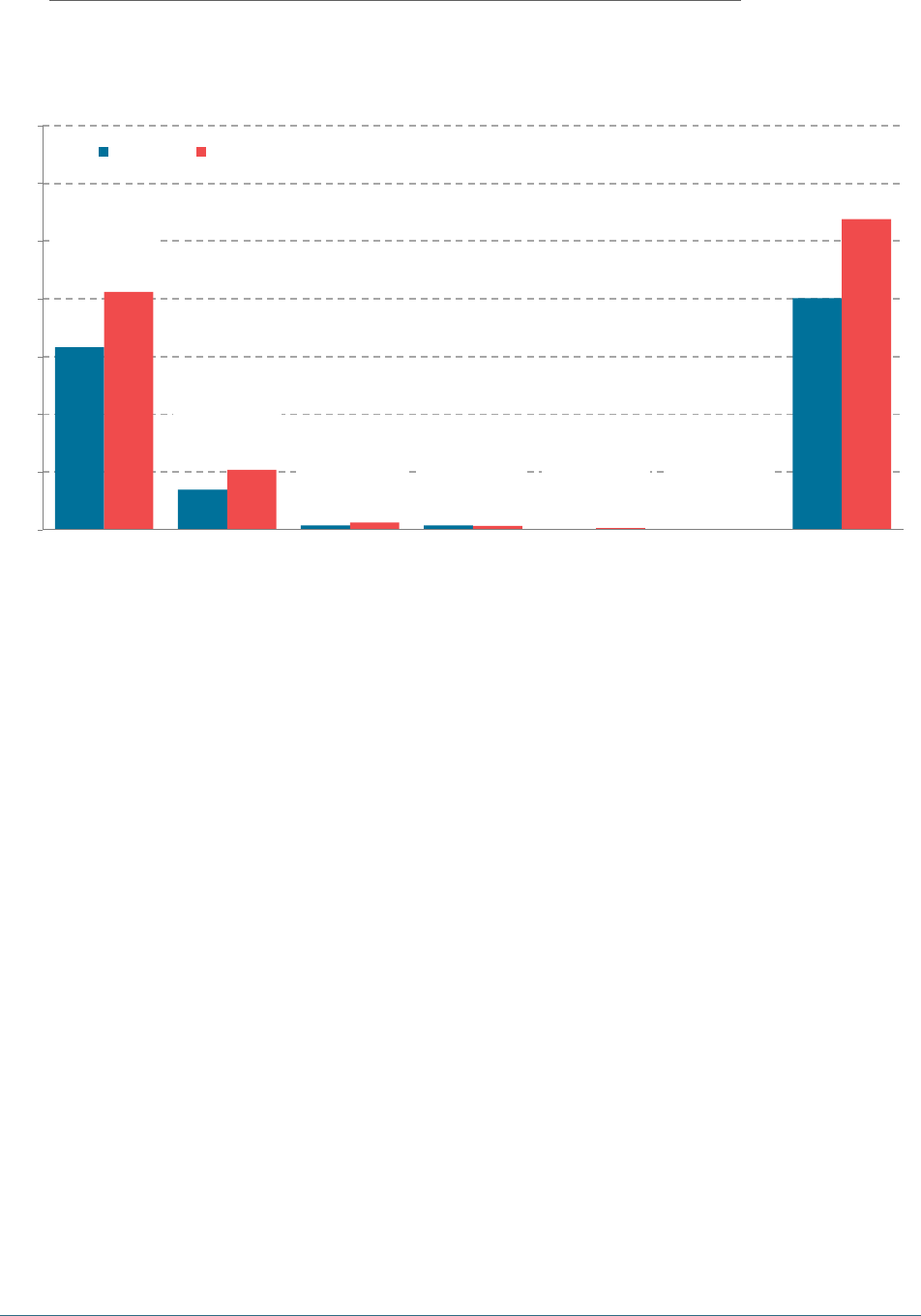
33
FIGURE 18: The WAS under-captures the number of UK businesses
Estimated number of UK businesses by number of employees employed by the
business: GB
Source ONS, Wealth and Assets Survey (2016–18); Department for Business, Energy & Industrial Strategy,
Business Population Estimate (2017).
Housing wealth
While business wealth is under-estimated in the WAS, housing wealth appears to be over-
estimated relative to external data sources such as the Nationwide, ONS, and Halifax
house price indices, and the national accounts.
33
Average house prices were £76,000
higher in the WAS than in these house price indices in 2014–16. It is not clear why people
should be overly optimistic to such an extent, though the WAS does not appear to be
the only survey affected by this (see Hillyard, Patsios and Feely, 2014, for evidence of a
similar pattern in Northern Ireland). It is possible that this bias could change through
the economic cycle. In Appendix A, we consider how rescaling housing wealth to match
these external figures affects our estimates of the wealth distribution.
Residency and citizenship
The final material gap in our understanding of wealth in the UK comes from a lack of
data on the residency, citizenship, and tax status of the individuals covered by the WAS
and STRL. The WAS sampling methodology is based on addresses in Great Britain which
means that for an individual to be included they just need to live at an address in Great
Britain for at least some of the time. The STRL criteria for inclusion are based on having
a material connection to the UK – for example, Richard Branson, fortieth in the 2020 Rich
33 See ONS (2018) for more details on the difference between measures of wealth in WAS and in other data sources. In Appendix A,
we compare components of wealth, including housing, between the WAS and the national accounts.
3.2m
0.7m
0.1m
0.1m
0.0m
0.0m
4.0m
4.1m
1.0m
0.1m
0.1m
0.0m
0.0m
5.4m
WAS is
23% below BPE
WAS is
33% below BPE
WAS is
40% below BPE
WAS is
13% above BPE
WAS is
89% below BPE
WAS is
35% below BPE
WAS is
25% below BPE
0m
1m
2m
3m
4m
5m
6m
7m
None 1 to 9 10 to 19 20 to 49 50 to 249 250 to 499 Total
WAS Business Population Estimate (BPE)
The UK’s wealth distribution and characteristics of high-wealth households |
Resolution Foundation
34
List, is not a permanent UK resident or UK domiciliary but does have businesses that
operate in the UK. This has particular relevance for policymakers considering introducing
wealth taxes: some of the wealth that is captured by both the WAS and the STRL will be
held by people who are not UK tax residents and therefore could fall out of scope of any
tax base. Conversely, WAS underestimates housing wealth held by non-residents and
rented out: while the property is included in the sampling frame, and the renters who
live in it are within the scope of the survey, these renters would not report the property
wealth since it is not theirs.
Conclusion
This paper describes what we know about UK wealth as well as acknowledging what we
do not know. A few facts are apparent from our analysis. Household wealth has grown
in the UK and is very unequally held. These trends have been particularly stark since
the financial crisis. Much of the gains in household wealth have been in rising financial
asset prices (with associated increased in pension wealth) leading to a small shift in
wealth shares towards the top of the wealth distribution. For those households who have
become richer over the past decade, most of these gains were not as a result of active
saving, rather passive accumulation in the value of wealth for those families who were
already lucky enough to be well-off. This has profound implications for any policymaker
thinking of introducing a net wealth tax in the wake of the coronavirus crisis.
While we can say a lot about wealth in the UK, there remains significant uncertainty
over the true scale of wealth in the UK. Survey measures of wealth appear to be under-
capturing wealth significantly – by as much as 7% according to our preferred estimate.
This missing wealth is likely to be as a result of underreported business and financial
assets.
More work is needed on data and analysis to properly understand and account for
the scale of household wealth in the UK. The past decade has seen wealth levels rise
remarkably as interest rates have fallen. The current economic crisis suggests interest
rates are unlikely to revert to the average levels seen in the second half of the twentieth
century. This means policymakers need to grapple with the now embedded gaps
between richer and poorer households. A good starting point would be to improve our
understanding of wealth in the UK with redoubled government efforts to fully measure it.
The UK’s wealth distribution and characteristics of high-wealth households |
Resolution Foundation
35
References
Advani, A., & Summers, A. (2020). Capital Gains and UK Inequality. CAGE Working Paper
No. 465.
Alvaredo, F., Atkinson, A. B., & Morelli, S. (2018). Top wealth shares in the UK over more
than a century. Journal of Public Economics, Vol. 162, pp. 26-47.
Alvaredo, F., Atkinson, A. B., & Morelli, S. (2016). The Challenge of Measuring UK Wealth
Inequality in the 2000s. Fiscal Studies, Vol. 37, Issue 1, pp. 13-33.
Appleyard, L., & Rowlingson, K. (2010). Home-ownership and the distribution of personal
wealth. JRF programme paper: Housing Market Taskforce.
Bach, L., Calvet, L. E., & Sodini, P. (2020). Rich Pickings? Risk, Return, and Skill in
Household Wealth. American Economic Review, Vol. 110, No. 9, pp. 2703-2747.
Bach, S., Thiemann, A., & Zucco, A. (2019). Looking for the missing rich: tracing the top tail
of the wealth distribution, International Tax and Public Finance, Vol. 26, pp. 1234-1258.
Bangham, G., & Leslie, J. (2020). Rainy Days: An audit of household wealth and the initial
effects of the coronavirus crisis on saving and spending in Great Britain, Resolution
Foundation.
Brewer, M., Corlett, A., Handscomb, K., McCurdy C., & Tomlinson, D. (2020). The Living
Standards Audit 2020. Resolution Foundation.
B&CE. (2019). The Gender Pensions Gap Tackling the motherhood penalty. The People’s
Pension, Available: https://thepeoplespension.co.uk/info/wp-content/uploads/
sites/3/2019/05/Gender-pension-gap-report-2019.pdf.
Corlett, A., Advani, A., & Summers, A. (2020). Who gains? The importance of accounting
for capital gains, Resolution Foundation.
Corlett, A., Clarke, S., D’Arcy, C., & Wood, J. (2018). The Living Standards Audit 2018,
Resolution Foundation.
Crawford, R., Innes, D., & O’Dea, C. (2016). Household Wealth in Great Britain: Distribution,
Composition and Changes 2006–12. Fiscal Studies, Vol. 37, No. 1.
D’Arcy, C., & Gardiner, L. (2017). The generation of wealth: asset accumulation across and
within cohorts. Resolution Foundation.
Davies, J., Lluberas, R., & Shorrocks, A. (2019). Credit Suisse Global Wealth Databook 2017.
Credit Suisse Research Institute, Zurich.
The UK’s wealth distribution and characteristics of high-wealth households |
Resolution Foundation
36
Department for Business, Energy & Industrial Strategy, (2017), Business Population
Estimates, electronic dataset. Available: https://www.gov.uk/government/collections/
business-population-estimates.
Klass, O. S., Biham, O., Levy, M., Malcai, O., & Solomon, S. (2006). The Forbes 400 and the
Pareto wealth distribution. Economics Letters, Vol. 90, Iss. 2, pp. 290-295.
Fagereng, A., Holm, M. B., Moll, B., & Natvik, G. (2019). Saving Behavior Across the Wealth
Distribution: The Importance of Capital Gains. NBER Working Paper No. 26588.
Fagereng, A., Guiso, L., Malacrino D., & Pistaferri, L. (2020). Heterogeneity and Persistence
in Returns to Wealth. Econometrica, Vol. 88, Iss. 1, pp.115-170.
Gabaix, X., & Ibragimov, R. (2012). Rank – ½: A simple way to improve the OLS estimation
of tail exponents. Journal of Business and Economic Statistics, Vol. 29, Iss. 1, pp. 24-39.
Gagnon, J., Leslie, J., Rahman F., & Smith, J. (2019). Quantitative (displ)easing?: Does QE
work and how should it be used next time? Resolution Foundation.
HMRC. (2019). UK Personal Wealth Statistics 2014 to 2016.
Hillyard, P., Patsios, D., & Feely, N. (2014). An exploratory study of the wealth of
older people in Ireland – North and South. Belfast: Centre for Ageing Research and
Development in Ireland.
Jones, C. I. (2015). Pareto and Piketty: The Macroeconomics of Top Income and Wealth
Inequality. Journal of Economic Perspectives, Vol. 29, Iss. 1, pp. 29-46.
Lachowska, M., & Myck, M. (2015). The effect of public pension wealth on saving and
expenditure. American Economics Journal: Economic Policy, Vol. 10, Iss. 3, pp. 284-308.
McKnight, A., & Karagiannaki, E. (2013). The wealth effect: how parental wealth and own
asset-holdings predict future advantage, In: J. Hills, F. Bastagli, F. Cowell, H. Glennerster,
E. Karagiannaki, and A. McKnight, ed., Wealth in the UK: Distribution, Accumulation, and
Policy, Oxford Scholarship Online, Chapter 6.
Miles, D., & Monro, V. (2019). UK house prices and three decades of decline in the risk-free
real interest rate. Bank of England, Staff Working Paper No. 837.
Mulheirn, I. (2019). Tackling the UK housing crisis: is supply the answer? UK Collaborative
Centre for Housing Evidence, Available: https://housingevidence.ac.uk/wp-content/
uploads/2019/08/20190820b-CaCHE-Housing-Supply-FINAL.pdf.
Mulheirn, I. (2020). Sources of wealth and their implications for taxation. Wealth Tax
Commission Background Paper, 122.
The UK’s wealth distribution and characteristics of high-wealth households |
Resolution Foundation
37
ONS. (2018). Wealth and Assets Survey (WAS) Wave 5: Validation of figures against
external sources. Available: https://www.ons.gov.uk/peoplepopulationandcommunity/
personalandhouseholdfinances/incomeandwealth/methodologies/
wealthandassetssurveywaswave5validationoffiguresagainstexternalsources
ONS. (2019a). Total Wealth: Wealth in Great Britain. December 2019, Available: https://
www.ons.gov.uk/peoplepopulationandcommunity/personalandhouseholdfinances/
incomeandwealth/datasets/totalwealthwealthingreatbritain.
ONS. (2019b). National population projections: 2018-based. October 2019, Available:
https://www.ons.gov.uk/peoplepopulationandcommunity/populationandmigration/
populationprojections/bulletins/nationalpopulationprojections/2018based.
ONS. (2020). Early indicator estimates from the Wealth and Assets Survey: attitudes
towards financial security, April 2018 to September 2019, Available: https://www.
ons.gov.uk/peoplepopulationandcommunity/personalandhouseholdfinances/
incomeandwealth/bulletins/earlyindicatorestimatesfromthewealthandassetssurvey/
attitudestowardsfinancialsecurityapril2018toseptember2019.
Piketty, T. (2014). Capital in the Twenty-First Century. Harvard University Press, Translated
by Arthur Goldhammer.
Rowlingson, K., Sood, A., & Tu, T. (2020). Public Attitudes to a Net Wealth Tax. Wealth Tax
Commission Evidence Paper, 2.
Sachweh, P., & Eicher, D. (2020). Soak the rich? A survey experiment on popular support
for wealth taxation in Germany, SASE conference paper.
Saez, E., & Zucman, G. (2016). Wealth Inequality in the United States since 1913: Evidence
from Capitalized Income Tax Data. The Quarterly Journal of Economics, Vol. 131, Iss. 2, pp.
519-578.
Saez, E., & Zucman, G. (2020a). Comments on Smith, Zidar and Zwick (2020). Available:
http://gabriel-zucman.eu/files/SZ2020CommentsOnSZZ2.pdf.
Saez, E., & Zucman, G. (2020b). Trends in US Income and Wealth Inequality: Revising After
the Revisionists. NBER Working Paper No. 27921.
Slaughter, H. (2020). Enrol up! The case for strengthening auto-enrolment enforcement.
Resolution Foundation.
Smith, M., Zidar, O., & Zwick, E. (2020). Top Wealth in America: New Estimates and
Implications for Taxing the Rich. Available: https://scholar.princeton.edu/sites/default/
files/zidar/files/szz-wealth.pdf.
The UK’s wealth distribution and characteristics of high-wealth households |
Resolution Foundation
38
Vermeulen, P. (2018). How Fat is the Top Tail of the Wealth Distribution? The Review of
Income and Wealth, Vol. 64, Iss. 2, pp. 357-387.
Watts, R. (2020). Rich List 2020 methodology: how the guide to wealth was compiled.
Sunday Times Article, 16 May 2020.
The UK’s wealth distribution and characteristics of high-wealth households |
Resolution Foundation

39
Appendix A: Comparing WAS to other datasets
Comparing total wealth
The ONS official estimate of total wealth in Great Britain 2016–18 is £14.6 trillion. Using
our definition of wealth, which includes business assets and adjusts the value of physical
wealth, we estimate total wealth in the WAS at £14.4 trillion. Our concern is that this
misses some wealth at the top, primarily due to survey under-coverage. In Section 4 we
describe our method for estimating this missing wealth by adding in wealth captured
in the Sunday Times Rich List, and using a Pareto adjustment to impute any additional
missing wealth. After adjusting for missing wealth, we estimate total wealth at £15.1
trillion.
These estimates are considerably higher than in external data sources. In the national
accounts, personal sector net worth is just £10.3 trillion in 2017. Alvaredo, Atkinson and
Morelli (2018), who estimate total wealth based on inheritance tax data, find £5.5 trillion
of UK wealth in 2012. Extrapolating this forward to 2017 using annual growth in personal
sector net worth from the national accounts gives a total of £7.6 trillion in 2017. These
discrepancies reflect differences in what is included and how this is measured. Table 1
compares each wealth component in our total with the corresponding component in the
national accounts. The exclusion of physical wealth in the national accounts explains
only a small proportion of the difference. Housing wealth is around £0.8 trillion higher
in the WAS relative to the national accounts, consistent with the finding that the WAS
overestimates housing wealth relative to external house price indices (see Section 4.3).
Below, we consider what happens to our standard and Pareto-adjusted estimates of
total wealth and top shares when housing wealth is rescaled to correct for this over-
estimation.
The largest discrepancy between our estimates and the national accounts is in pension
wealth, which is over £2 trillion higher in the WAS than in the national accounts. In
part, this reflects differences in the types of pension included. The national accounts
exclude unfunded defined benefit pensions paid by general government (including civil
service pensions, for instance). However, this cannot fully explain the difference, as
supplementary estimates indicate that these pensions were worth only £0.9 trillion in
2015.
34
A possible explanation for the variation is the different methods used to compute
the value of Defined Benefit pensions, which are much harder to value than wealth held
in defined contribution pensions.
34 For more details on the pension wealth sources included in the core national accounts and supplementary estimates
of excluded pension wealth see https://www.ons.gov.uk/economy/nationalaccounts/uksectoraccounts/articles/
pensionsinthenationalaccountsafullerpictureoftheuksfundedandunfundedpensionobligations/2010to2015
The UK’s wealth distribution and characteristics of high-wealth households |
Resolution Foundation

40
Excluding pension wealth from both data sources reduces our WAS total (before Pareto
adjustment) to £8.3 trillion, and the national accounts total to £6.5 trillion. This is much
closer to the estimate in Alvaredo, Atkinson and Morelli (2018), which excludes pension
wealth. Below, we consider how our top share estimates compare to Alvaredo, Atkinson
and Morelli (2018) when we exclude pension wealth from our definition.
TABLE 1: It is difficult to reconcile official estimates of total UK wealth
Total wealth in the WAS and the national accounts, £ trillion
WAS total (our
definition)
Pareto-adjusted
WAS
National
Accounts
Total 14.4 15.1 10.3
Property wealth (net) 5.1 5.1 4.3
Pension wealth 6.1 6.1 3.8
Financial wealth (net) 1.7 1.7 2.1
Business wealth 1.0 1.0 0.04
Physical wealth 0.5 0.5 N.a.
Net STRL adjustment (add
wealth captured in the STRL
but not in the WAS)
N.a. 0.4
Pareto adjustment N.a. 0.4 N.a.
NOTES: The classification of national accounts components into categories consistent with the WAS is
subject to various assumptions. For example, mortgages and loans secured against property are combined
with consumer loans in the national accounts. In this table, to compute estimates of net property wealth
and net financial wealth, we allocate loans proportionally to the value of property assets in property assets
plus financial assets, and similarly for financial wealth. Our definition of ‘business wealth’ in the national
accounts includes machinery and equipment, cultivated biological resources, intellectual property
products, and inventories owned by the household sector. This is not a comprehensive measure of all
assets held in private businesses. Pension wealth in the national accounts also includes the value of
insurance schemes. In this table, we do not take a stance on how STRL wealth and additional Pareto wealth
should be allocated across different asset classes. In Figure 16, we illustrate what the composition of
wealth might look like if we assume all STRL and Pareto wealth reflects financial and business wealth.
SOURCE: ONS, Wealth and Assets Survey, Sunday Times Rich List, UK National Accounts.
A natural question to ask is, if total wealth in the WAS is already higher than in the
national accounts after reconciling some of the obvious differences, what is this
‘missing wealth’ that we are allocating in our Pareto adjustment? It is worth noting that
though some components of wealth appear to have consistent values across these
data sources (such as financial wealth), this similarity may be misleading. Conceptual
and methodological differences between the national accounts and survey data are
The UK’s wealth distribution and characteristics of high-wealth households |
Resolution Foundation

41
endless, and reconciling these to understand how the figures compare when we actually
compare like-for-like is an important task for future research. In the absence of such
a reconciliation, it is possible that the missing wealth at the top that we estimate in
our Pareto adjustment is indeed captured in the national accounts, but that the WAS
also measures sources of household wealth that the national accounts is not trying
to capture, or uses valuation methods which produce alternative, higher measures of
household wealth.
We do not believe that the national accounts tell us the ‘true’ value of wealth that we
would expect to find in the absence of any under-reporting or under-coverage using our
WAS-based definition of wealth. Our WAS-based wealth total is, in fact, higher than total
wealth as measured and defined in the national accounts. As a result, we have not taken
the approach used by Credit Suisse (Davies, Lluberas and Shorrocks, 2019), who fit a
Pareto distribution to the top tail but rescale total adjusted wealth to target the national
accounts total. Nor do we attempt to match an external total for business wealth when
adjusting on this measure, since no comparable total exists. Since the target wealth total
is below observed total wealth, this approach effectively redistributes wealth from the
bottom of the distribution to the top, while subtracting rather than adding anything to
the total.
Top shares using alternative measures of wealth
In this section, we present some alternative estimates of the share of wealth at the top
of the distribution in order to compare with Alvaredo, Atkinson and Morelli (2018). This
is across two dimensions: (i) rescaling the value of housing wealth in order to match
average house prices from Nationwide house price data,
35
and (ii) excluding pensions.
36
Rescaling housing wealth has a small impact on top shares (Figure A1). Before adjusting
for missing wealth at the top, the top 10% (1%) share rises (falls) by 1 percentage point
in the period of overlap with Alvaredo, Atkinson and Morelli (2018). Their estimates are
based on estates data, which presumably does not include overly optimistic estimates of
housing wealth.
35 The average self-reported house price in the WAS is higher than average UK property prices in other data – for example
that compiled by Nationwide. This means housing wealth could be overvalued in the WAS, for example as a result of survey
respondents overestimating the value of their own properties.
36 The long-run comparison time series in these charts is compiled from inheritance tax data which excludes pension wealth. WAS
estimates might underestimate top wealth shares relative to the IHT data-based estimate because pension wealth is more evenly
distributed than other forms of wealth.
The UK’s wealth distribution and characteristics of high-wealth households |
Resolution Foundation
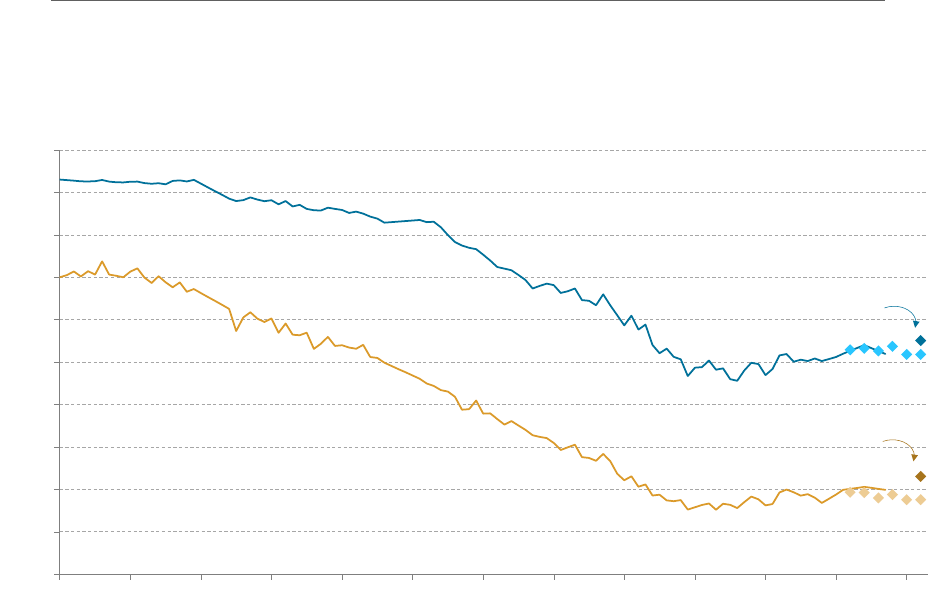
42
Figure A1: Rescaling WAS housing wealth does little change wealth inequality
estimates
Share of net personal wealth held by richest 1% and 10%, rescaling housing wealth and
including adjustments using the Sunday Times Rich List: UK and GB
NOTES: The WAS estimates are based on scaling gross property wealth in the WAS down by the ratio of the
WAS average house price in round 5 and the contemporaneous average property price in Nationwide data.
This equates to a reduction in gross property wealth by around 30 per cent.
SOURCE: World Inequality Database, 2020; ONS, Wealth and Assets Survey; Nationwide; Sunday Times
Rich List.
Excluding pension wealth (Fig. A2) raises our top shares significantly. In 2016–18, the top
1% share was 26% excluding pension wealth, compared to 18% including pension wealth.
This is not surprising, given that pension wealth is distributed more equally across the
wealth distribution than other sources of wealth, such as financial and business wealth
(see Figure 4). Excluding pension wealth also affects the trend in wealth concentration:
top shares of non-pension wealth rose significantly between 2008 and 2014, from 23%
to 26% for the top 1% and 52% to 58% for the top 10%, continuing the rise in wealth
inequality observed since the early 1980s. This is before taking into account wealth at the
top which is missing from the WAS. Our Pareto-adjusted top shares for 2016–18 for the
top 10% (1%) are 61% (31%).
1 per cent share
10 per cent share
WAS-based
estimate
WAS-based
estimate
0%
10%
20%
30%
40%
50%
60%
70%
80%
90%
100%
1895 1905 1915 1925 1935 1945 1955 1965 1975 1985 1995 2005 2015
Adjusted-WAS
Adjusted-WAS
The UK’s wealth distribution and characteristics of high-wealth households |
Resolution Foundation
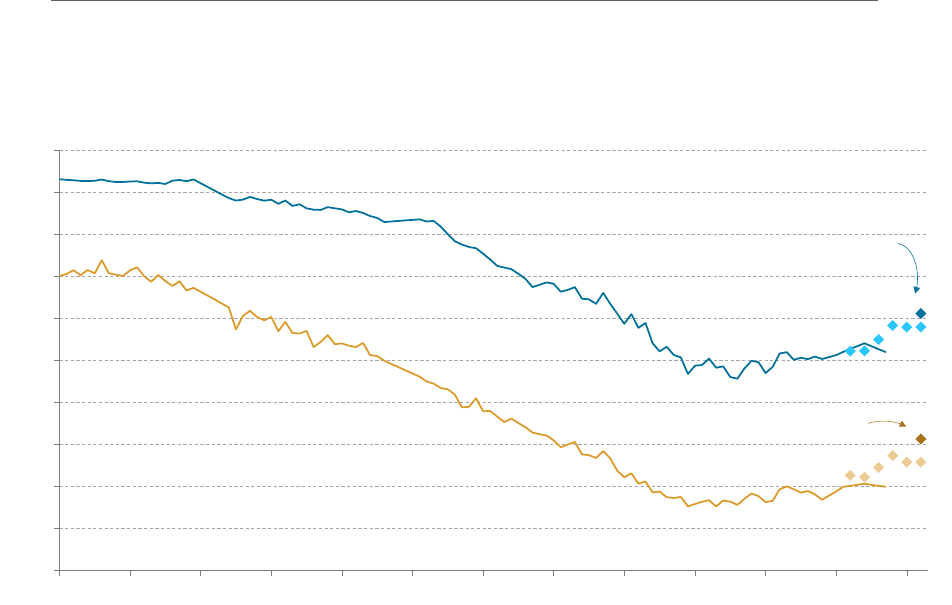
43
Figure A2: Estimates of inequality, excluding pension wealth, shows a big rise
since 2006-08
Share of net personal wealth held by richest 1% and 10%, excluding pensions and
including adjustments using the Sunday Times Rich List: UK and GB
NOTES: The WAS estimates exclude all pension wealth, including pensions in payment, occupational and
personal pensions.
SOURCE: World Inequality Database, 2020; ONS, Wealth and Assets Survey; Sunday Times Rich List.
In Figure A3, we combine the adjustments made to our wealth definition in the previous
two graphs by rescaling housing wealth and excluding pensions. This definition is the
most consistent with the wealth definition used in Alvaredo, Atkinson and Morelli (2018).
Accordingly, we find that top shares using this definition line up closely with the top
shares found in Alvaredo, Atkinson and Morelli (2018) during the years in which the series
overlap. Again, these estimates suggest that the rise in inequality observed since the
1980s has not abated in recent years, and if anything has accelerated.
1 per cent share
10 per cent share
WAS-based
estimate
WAS-based
estimate
0%
10%
20%
30%
40%
50%
60%
70%
80%
90%
100%
1895 1905 1915 1925 1935 1945 1955 1965 1975 1985 1995 2005 2015
Adjusted-WAS
Adjusted-WAS
The UK’s wealth distribution and characteristics of high-wealth households |
Resolution Foundation

44
Figure A3: Rescaling housing wealth marginally increases the level of inequality
Share of net personal wealth held by richest 1% and 10%, excluding pensions, rescaling
housing wealth, and including adjustments using the Sunday Times Rich List: UK and
GB
NOTES: The WAS estimates are based on scaling gross property wealth in the WAS down by the ratio of
the WAS average house price in round 5 and the contemporaneous average property price in Nationwide
data. This equates to a reduction in gross property wealth by around 30%. The WAS estimates exclude all
pension wealth, including pensions in payment, occupational and personal pensions.
SOURCE: World Inequality Database, 2020; ONS, Wealth and Assets Survey; Nationwide; Sunday Times
Rich List.
1 per cent share
10 per cent share
WAS-based estimate
WAS-based
estimate
0%
10%
20%
30%
40%
50%
60%
70%
80%
90%
100%
1895 1905 1915 1925 1935 1945 1955 1965 1975 1985 1995 2005 2015
Adjusted-WAS
Adjusted-WAS
The UK’s wealth distribution and characteristics of high-wealth households |
Resolution Foundation
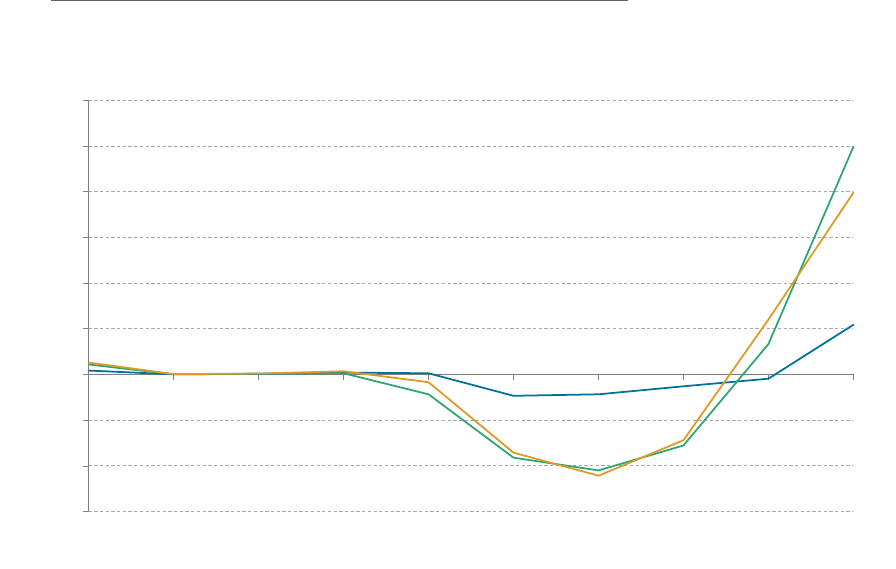
45
Appendix B: Inequality in wealth – individual level estimates
In this Appendix we reproduce some of the distributional analysis presented in the body
of the paper (Section 3) using individuals as our unit of analysis, rather than family units.
Figure B1: Top wealth shares have risen since 2006-08
Share of total net individual wealth by each net wealth decile since 2006–2008: GB
NOTES: Wealth is measured at the individual level. Total wealth includes net financial assets, net property
assets, pension assets, and an adjusted measure of physical wealth (including cars, home contents,
collectibles, etc). Private business assets are excluded due to material improvements in the coverage of
these assets since the early rounds of the survey making cross-round comparisons difficult.
SOURCE: ONS, Wealth and Assets Survey.
2008-10
2012-14
2016-18
-1.5ppts
-1.0ppts
-0.5ppts
0.0ppts
+0.5ppts
+1.0ppts
+1.5ppts
+2.0ppts
+2.5ppts
+3.0ppts
1
(lowest)
2 3 4 5 6 7 8 9 10
(highest)
The UK’s wealth distribution and characteristics of high-wealth households |
Resolution Foundation
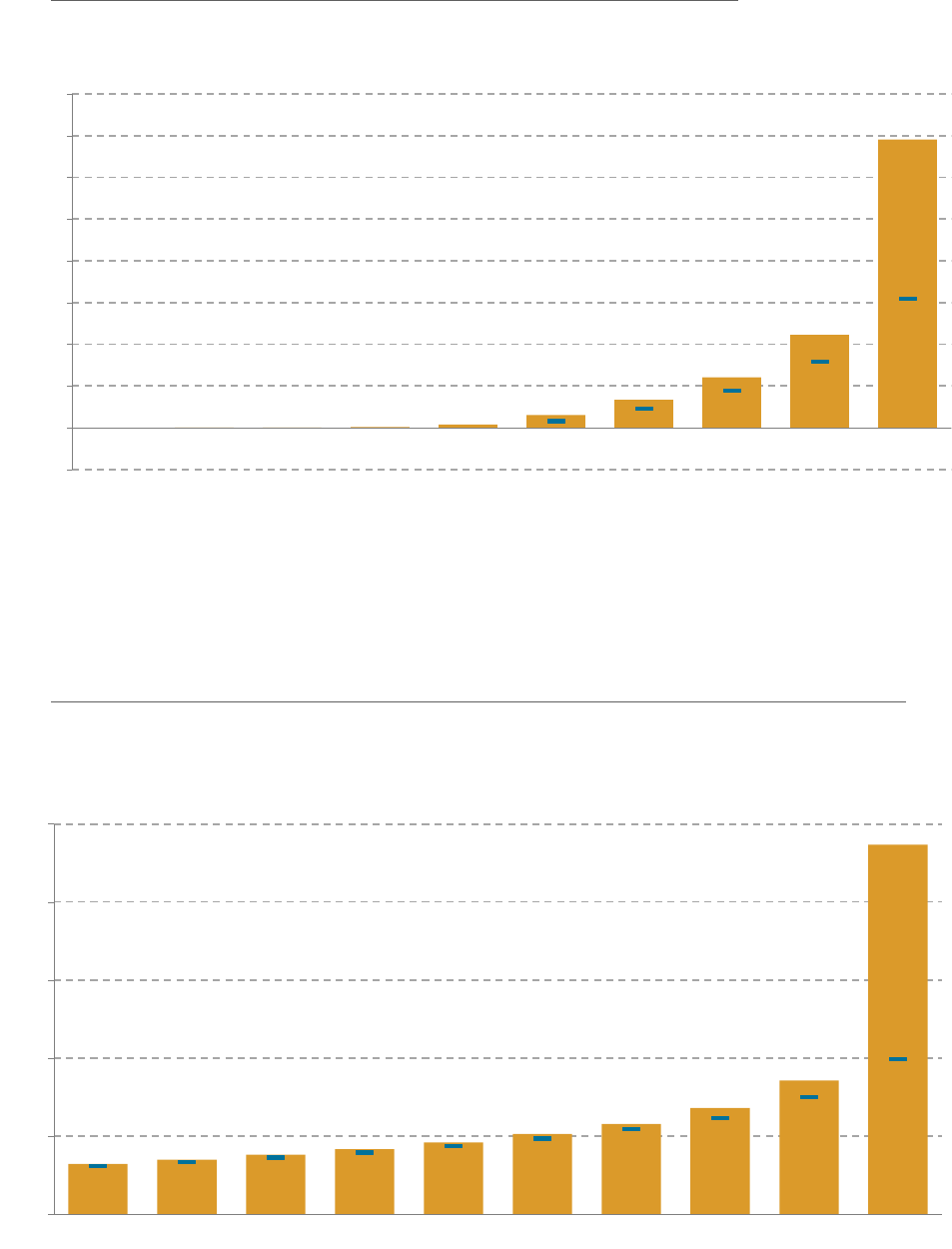
46
Figure B2: Gaps between wealthy and typical individuals is huge
Average net individual wealth within each net wealth decile: GB, 2016–2018
NOTES: Wealth is measured at the individual level. Total wealth includes net financial assets, net property
assets, pension assets, business assets and an adjusted measure of physical wealth (including cars, home
contents, collectibles, etc).
SOURCE: ONS, Wealth and Assets Survey.
Figure B3: Gaps between the very wealthiest individuals and others is also huge
Average net individual wealth within each net wealth percentile for the wealthiest 10%:
GB, 2016–2018
NOTES: Wealth is measured at the individual level. Total wealth includes net financial assets, net property
assets, pension assets, business assets and an adjusted measure of physical wealth (including cars, home
contents, collectibles, etc).
SOURCE: ONS, Wealth and Assets Survey.
-£0.0m
£0.0m
£0.0m
£0.0m
£0.0m
£0.1m
£0.1m
£0.2m
£0.4m
£1.4m
-£0.2m
£0
£0.2m
£0.4m
£0.6m
£0.8m
£1.0m
£1.2m
£1.4m
£1.6m
1
(lowest)
2 3 4 5 6 7 8 9 10
(highest)
—
denotes minimum wealth within group
£0.6m £0.7m £0.8m £0.8m £0.9m £1.0m £1.2m £1.4m £1.7m £4.7m
£0
£1m
£2m
£3m
£4m
£5m
91 92 93 94 95 96 97 98 99 100
—
denotes minimum wealth within group
The UK’s wealth distribution and characteristics of high-wealth households |
Resolution Foundation
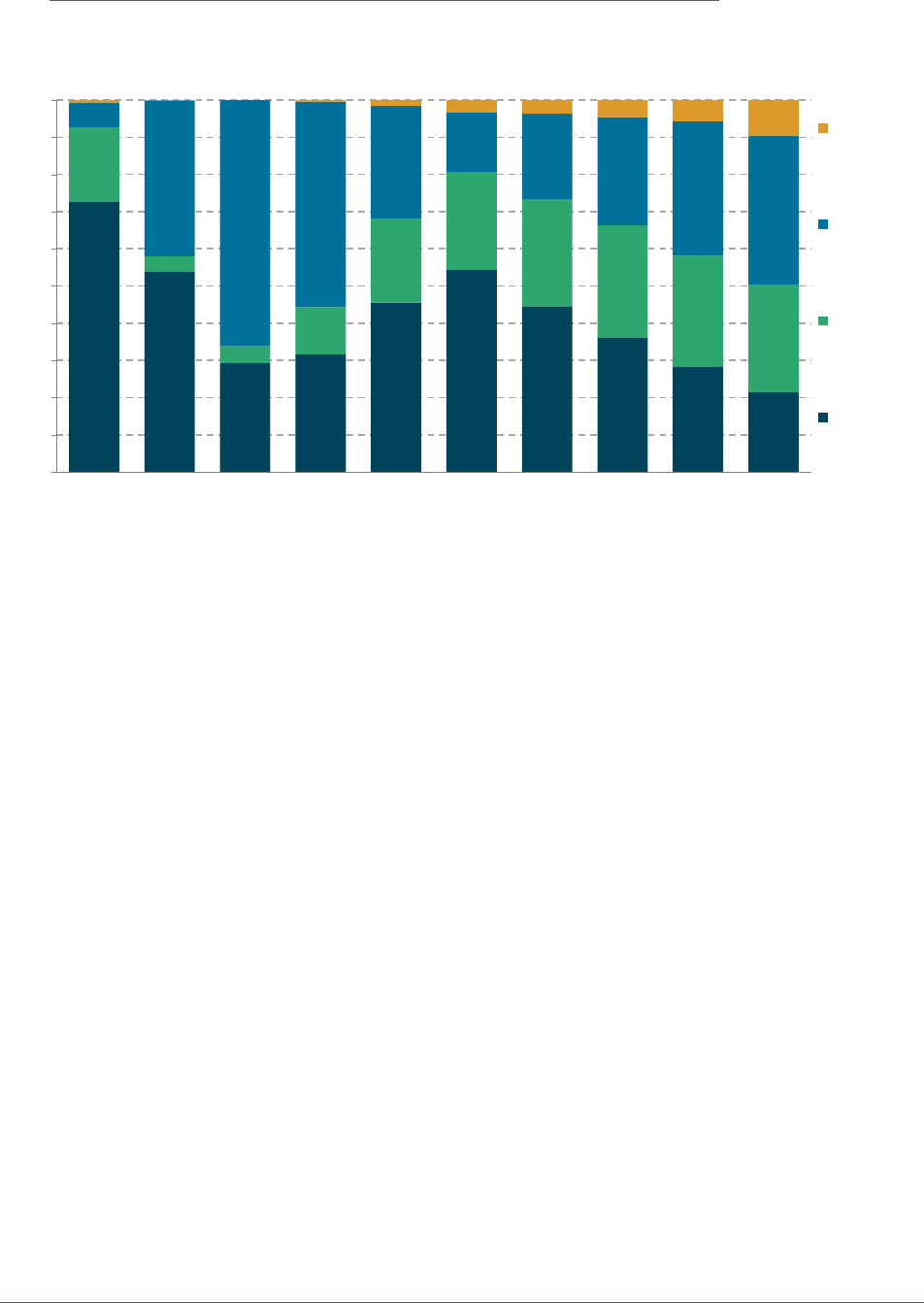
47
Figure B4: Wealthier individuals have more risky financial assets
Composition of financial assets by individual net wealth decile: GB 2016–2018
NOTES: Zero-return assets include cash, current accounts and other informal financial assets. Savings
assets include savings accounts (i.e. interest-bearing sight deposit accounts) and national savings
products. Safe assets include ISA accounts,37 saving bonds (i.e. fixed term saving accounts), unit and
investment trusts, insurance products and other formal financial assets. Risky assets include domestic and
overseas shares and bonds.
SOURCE: ONS, Wealth and Assets Survey.
37 This includes both cash ISAs (which would be more similar to savings assets in this taxonomy) and stocks and shares ISAs. We
have included both within the ‘safe assets’ group because both these ISA accounts would typically have a higher yield than non-
ISA savings accounts.
73%
54%
29%
32%
46%
54%
45%
36%
28%
21%
20%
4%
5%
13%
22%
26%
29%
30%
30%
29%
6%
42%
66%
55%
30%
16%
23%
29%
36%
40%
4%
5%
6%
10%
0%
10%
20%
30%
40%
50%
60%
70%
80%
90%
100%
1
(lowest)
2 3 4 5 6 7 8 9 10
(highest)
Risky
assets
Safe assets
Savings
assets
Zero-return
assets
The UK’s wealth distribution and characteristics of high-wealth households |
Resolution Foundation
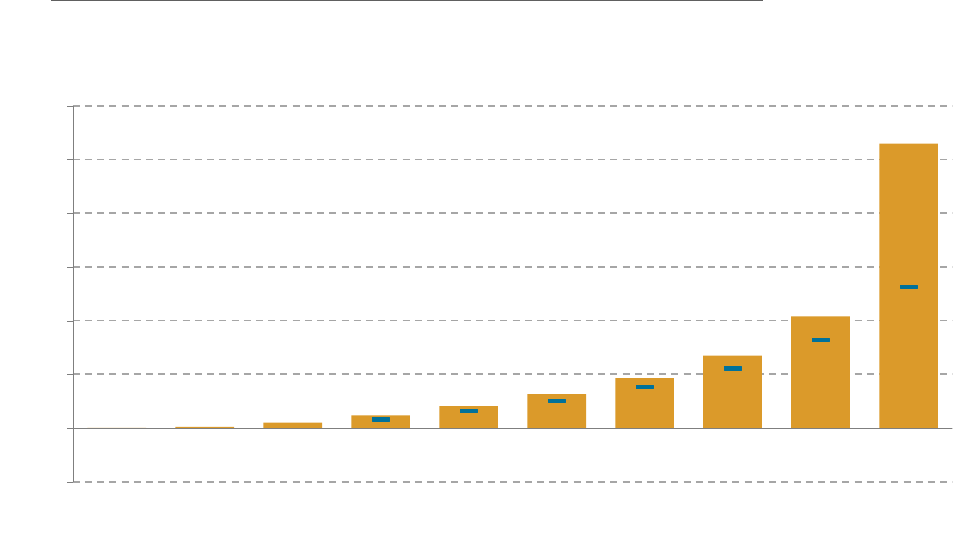
48
Appendix C: Inequality in wealth – household level estimates
In this Appendix we reproduce some of the distributional analysis presented in the body
of the paper (Section 3) using households as our unit of analysis, rather than family units.
Figure C1: Gaps between wealthy and typical households are large
Average net household wealth within each net wealth decile: GB, 2016–2018
NOTES: Wealth is measured at the household level. Total wealth includes net financial assets, net property
assets, pension assets, business assets and an adjusted measure of physical wealth (including cars, home
contents, collectibles, etc).
SOURCE: ONS, Wealth and Assets Survey.
-£0.0m
£0.0m
£0.0m
£0.1m
£0.2m
£0.3m
£0.5m
£0.7m
£1.0m
£2.6m
-£0.5m
£0
£0.5m
£1.0m
£1.5m
£2.0m
£2.5m
£3.0m
1
(lowest)
2 3 4 5 6 7 8 9 10
(highest)
—
denotes minimum wealth within group
The UK’s wealth distribution and characteristics of high-wealth households |
Resolution Foundation
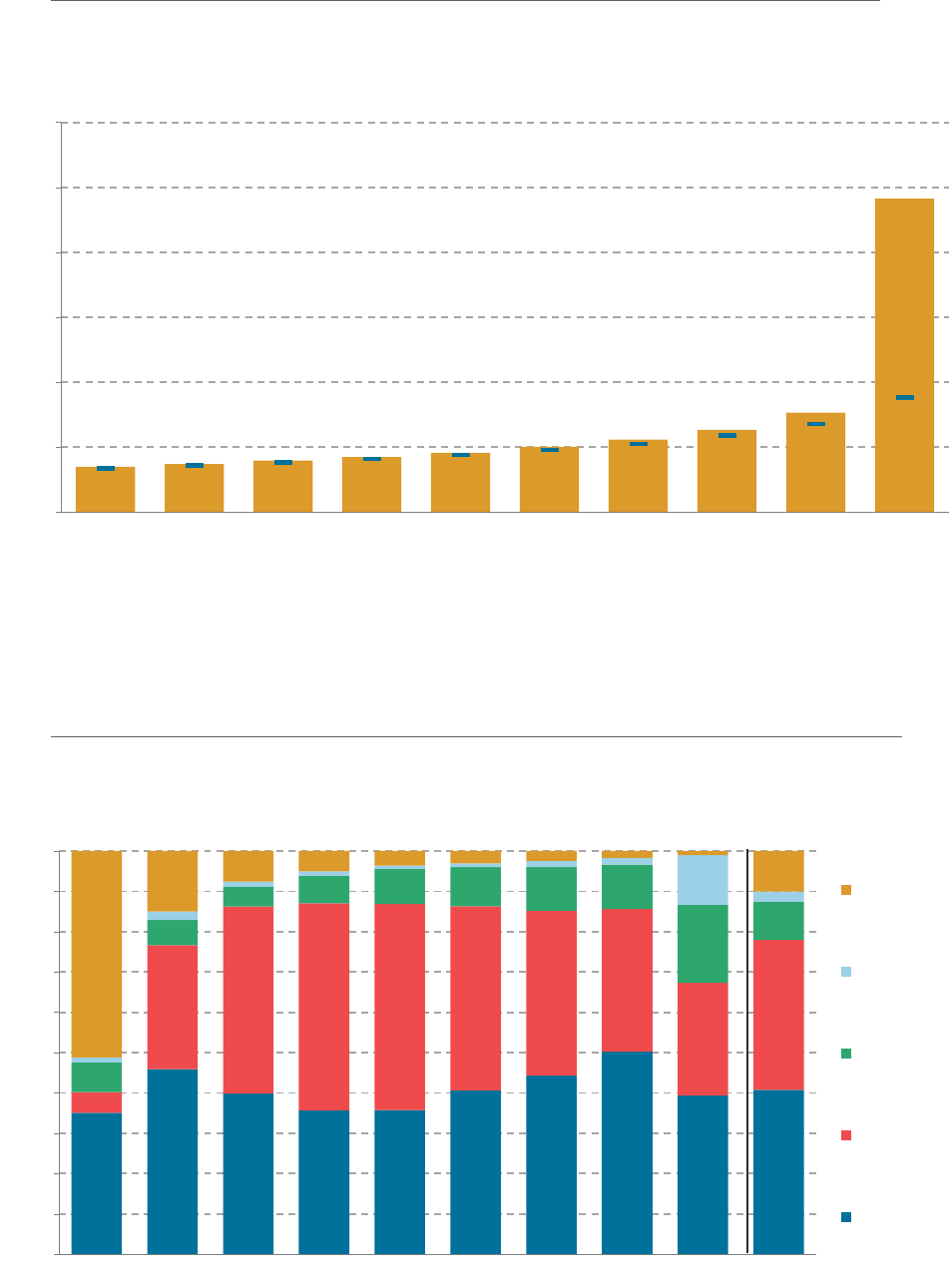
49
Figure C2: Gaps between the wealthiest households and others is even larger
Average net household wealth within each net wealth percentile for the wealthiest 10%:
GB, 2016–2018
NOTES: Wealth is measured at the household level. Total wealth includes net financial assets, net property
assets, pension assets, business assets and an adjusted measure of physical wealth (including cars, home
contents, collectibles, etc).
SOURCE: ONS, Wealth and Assets Survey.
Figure C3: Wealthier households hold much more business and financial assets
Average share of total net wealth contributed from different asset classes by household
net wealth decile: GB, 2016–2018
NOTES: The lowest decile is excluded, as net wealth is negative. Property wealth here is measured net of
mortgage debt and financial wealth is net of other financial liabilities.
SOURCE: ONS, Wealth and Assets Survey.
£1.4m £1.5m £1.6m £1.7m £1.8m £2.0m £2.2m £2.5m £3.1m £9.7m
£0
£2m
£4m
£6m
£8m
£10m
£12m
91 92 93 94 95 96 97 98 99 100
—
denotes minimum wealth within group
35%
46%
40%
36%
36%
41%
44%
50%
39%
41%
5%
31%
46%
51%
51%
46%
41%
35%
28%
37%
7%
6%
5%
7%
9%
10%
11%
11%
19%
9%
51%
15%
8%
5%
10%
0%
10%
20%
30%
40%
50%
60%
70%
80%
90%
100%
2 3 4 5 6 7 8 9 10 Average
Physical
Business
Financial
Property
Pension
The UK’s wealth distribution and characteristics of high-wealth households |
Resolution Foundation

50
Appendix D: Inequality in wealth – family level estimates excluding
main residential property wealth and pension wealth
In this Appendix we reproduce some of the distributional analysis presented in the
body of the paper (Section 3) using a modified definition of wealth which excludes main
residential property and/or pension wealth.
Figure D1: Most families have little wealth outside of main property and
pensions
Average net wealth per adult per family within each net wealth decile: GB, 2016–2018
NOTES: Wealth is measured at the family level – single or couple adults and any dependent children within
a household. Total wealth includes net financial assets, net property assets (excluding primary residence
and any mortgage attached to it), business assets and an adjusted measure of physical wealth (including
cars, home contents, collectibles, etc).
SOURCE: ONS, Wealth and Assets Survey.
-£7k
£0k
£2k
£5k
£10k
£16k
£27k
£50k
£101k
£568k
-£100k
£0
£100k
£200k
£300k
£400k
£500k
£600k
1
(lowest)
2 3 4 5 6 7 8 9 10
(highest)
—
denotes minimum wealth within group
The UK’s wealth distribution and characteristics of high-wealth households |
Resolution Foundation
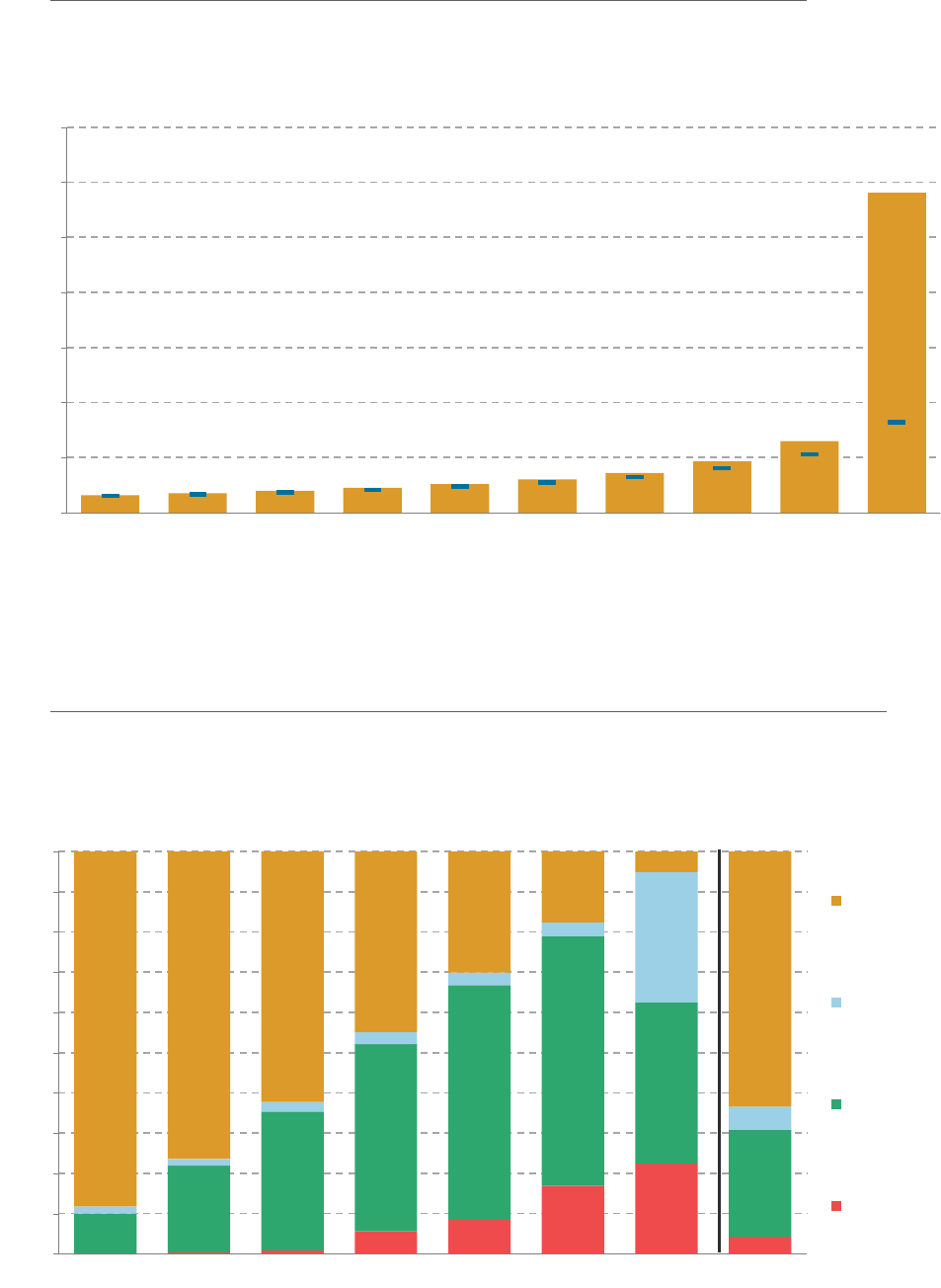
51
Figure D2: The gap between the richest families and others is very large
Average net wealth per adult per family within each net wealth percentile for the
wealthiest 10%: GB, 2016–2018
NOTES: Wealth is measured at the family level – single or couple adults and any dependent children within
a household. Total wealth includes net financial assets, net property assets (excluding primary residence
and any mortgage attached to it), business assets and an adjusted measure of physical wealth (including
cars, home contents, collectibles, etc).
SOURCE: ONS, Wealth and Assets Survey.
Figure D3: Most families hold most non-pension and non-main property wealth
in physical assets
Average share of total net wealth, excluding primary residences and pensions,
contributed from different asset classes by family net wealth decile: GB, 2016–2018
NOTES: The lowest three deciles are excluded as net wealth is negative for some components are negative.
Property wealth here is measured for non-primary residence properties net of their mortgage debt and
financial wealth is net of other financial liabilities. Pension wealth is excluded.
SOURCE: ONS, Wealth and Assets Survey.
£0.2m
£0.2m
£0.2m
£0.2m £0.3m £0.3m £0.4m £0.5m £0.6m £2.9m
£0
£0.5m
£1.0m
£1.5m
£2.0m
£2.5m
£3.0m
£3.5m
91 92 93 94 95 96 97 98 99 100
—
denotes minimum wealth within group
6%
8%
17%
22%
4%
10%
22%
35%
47%
58%
62%
40%
27%
32%
89%
76%
62%
45%
30%
18%
5%
63%
0%
10%
20%
30%
40%
50%
60%
70%
80%
90%
100%
4 5 6 7 8 9 10 Average
Physical
Business
Financial
Property
The UK’s wealth distribution and characteristics of high-wealth households |
Resolution Foundation
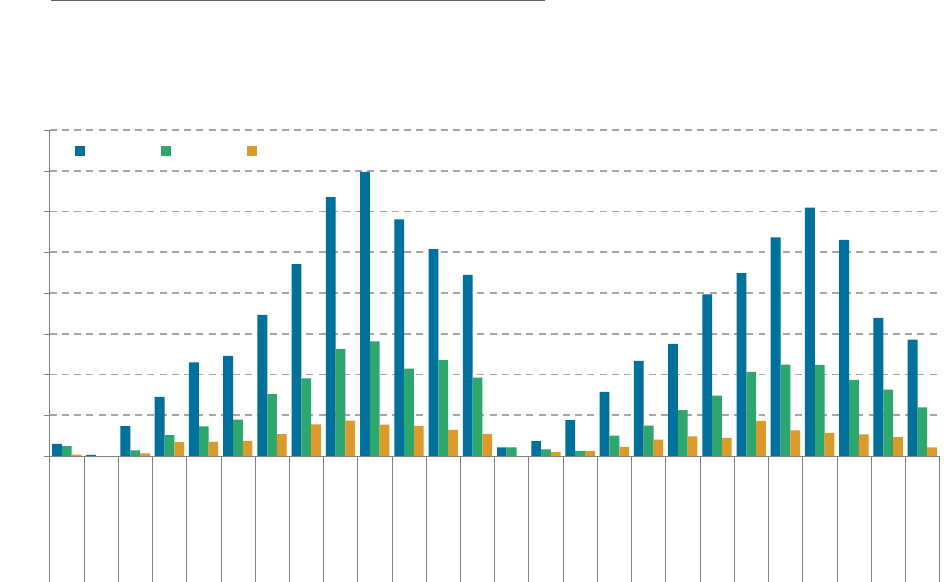
52
Appendix E: Characteristics of high-wealth families excluding main
property and pension wealth
In this Appendix, we present evidence on the characteristics of high-wealth families as in
the main body of the paper (Section 3.4) using an alternative definition of wealth which
excludes main residential property and pension wealth.
Figure E1: Age is an important driver of wealth
Share of age and sex group that live in high-wealth families (above £250,000 per adult):
GB 2016–2018
NOTES: Wealth thresholds are measured as total wealth per adult within the family. Wealth is measured
excluding net wealth from the primary residence and pension wealth.
SOURCE: ONS, Wealth and Assets Survey.
0%
2%
4%
6%
8%
10%
12%
14%
16%
Male
Male
Male
Male
Male
Male
Male
Male
Male
Male
Male
Male
Male
Female
Female
Female
Female
Female
Female
Female
Female
Female
Female
Female
Female
Female
20-
24
25-
29
30-
34
35-
39
40-
44
45-
49
50-
54
55-
59
60-
64
65-
69
70-
74
75-
79
80+ 20-
24
25-
29
30-
34
35-
39
40-
44
45-
49
50-
54
55-
59
60-
64
65-
69
70-
74
75-
79
80+
£250k £500k £1m
The UK’s wealth distribution and characteristics of high-wealth households |
Resolution Foundation
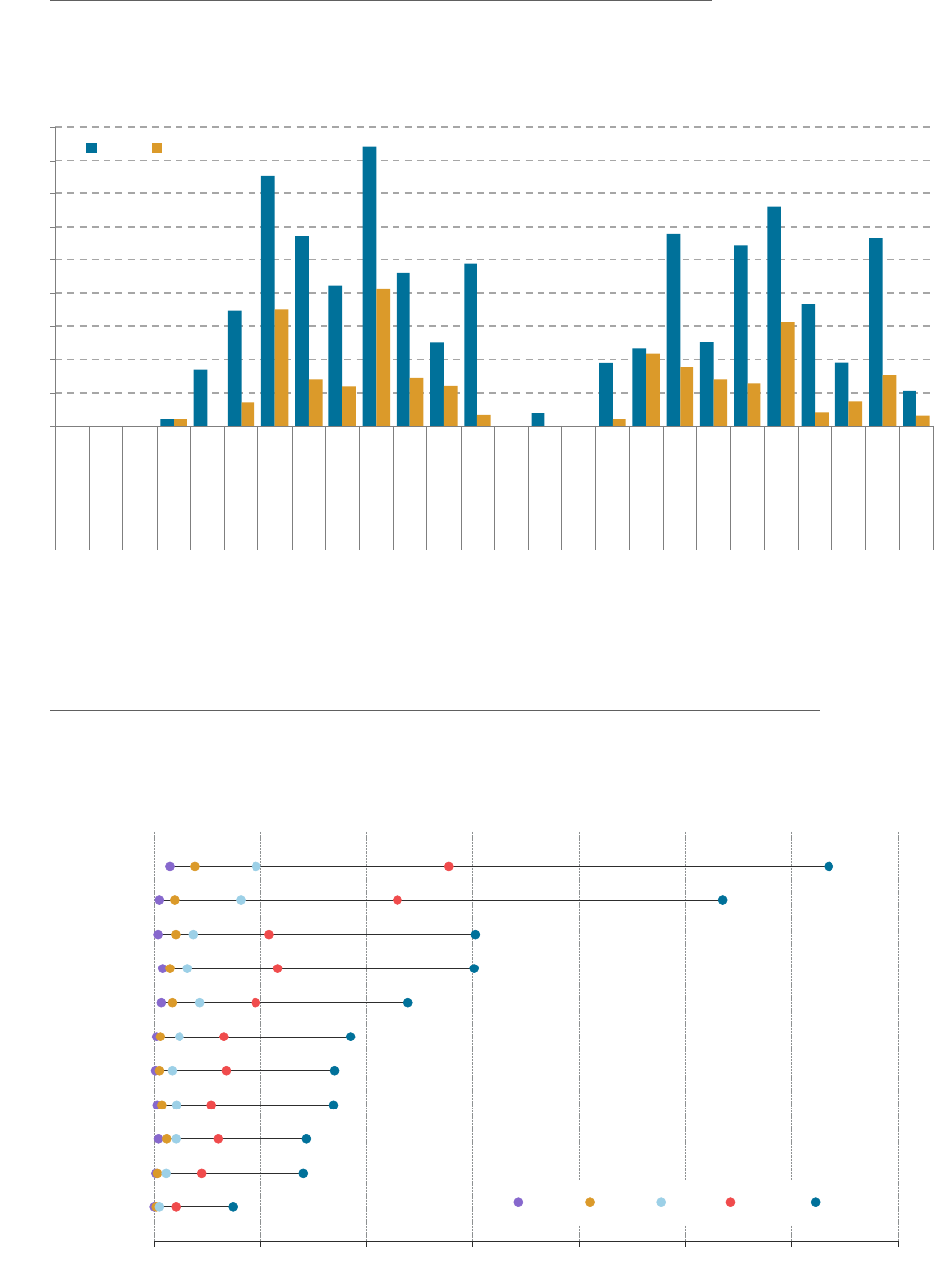
53
Figure E2: Age is a less important driver for the very wealthiest
Share of age and sex group that live in high-wealth families (above £2 million per adult):
GB 2016–2018
NOTES: Wealth thresholds are measured as total wealth per adult within the family. Wealth is measured
excluding net wealth from the primary residence and pension wealth.
SOURCE: ONS, Wealth and Assets Survey.
Figure E3: High wealth families are concentrated in the South of England
Number of high-wealth individuals by threshold level, calculated at the family level: GB,
2016–2018
NOTES: Wealth is measured excluding net wealth from the primary residence and pension wealth.
SOURCE: ONS, Wealth and Assets Survey.
0.0%
0.1%
0.2%
0.3%
0.4%
0.5%
0.6%
0.7%
0.8%
0.9%
Male
Male
Male
Male
Male
Male
Male
Male
Male
Male
Male
Male
Male
Female
Female
Female
Female
Female
Female
Female
Female
Female
Female
Female
Female
Female
20-
24
25-
29
30-
34
35-
39
40-
44
45-
49
50-
54
55-
59
60-
64
65-
69
70-
74
75-
79
80+ 20-
24
25-
29
30-
34
35-
39
40-
44
45-
49
50-
54
55-
59
60-
64
65-
69
70-
74
75-
79
80+
£2m £5m
South East
London
South West
East of England
North West
Yorkshire
West Midlands
East Midlands
Scotland
Wales
North East
0 0.1m 0.2m 0.3m 0.4m 0.5m 0.6m 0.7m
£5m £2m £1m £500k £250k
The UK’s wealth distribution and characteristics of high-wealth households |
Resolution Foundation
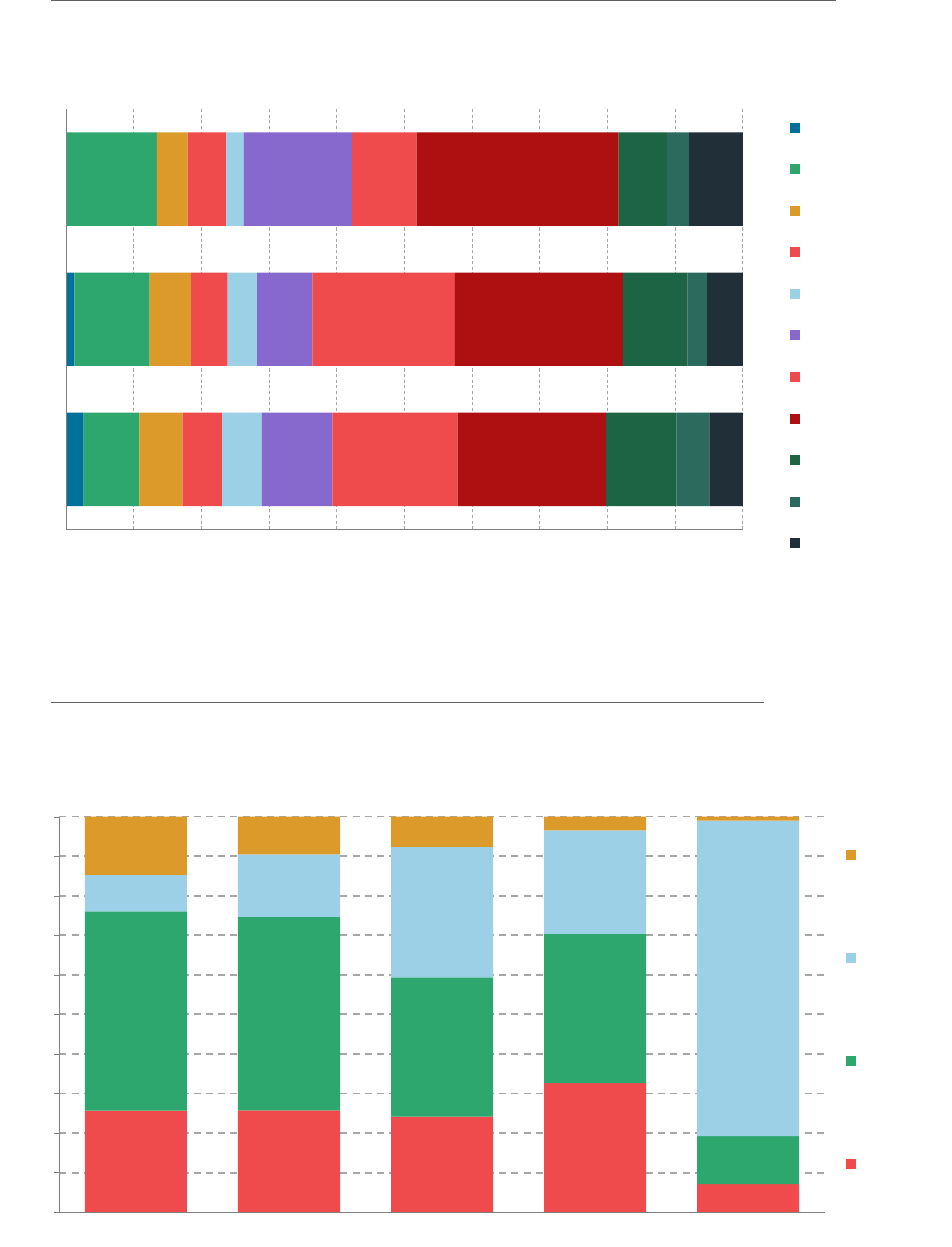
54
Figure E4: The South East of England has the share of the very wealthiest
families
Share of all families above wealth threshold by region: GB 2016–2018
NOTES: Wealth is measured excluding net wealth from the primary residence and pension wealth.
SOURCE: ONS, Wealth and Assets Survey.
Figure E5: Business assets are only material for the top 10 per cent
Composition of net wealth by groups captured by each threshold: GB,
2016-2018
NOTES: Wealth is measured excluding net wealth from the primary residence and pension wealth. It is
measured at the family level – single or couple adults and any dependent children within a household. Total
wealth includes net financial assets, net property assets (excluding net wealth from the primary residence),
business assets and an adjusted measure of physical wealth (including cars, home contents, collectibles,
etc).
SOURCE: ONS, Wealth and Assets Survey.
0% 10% 20% 30% 40% 50% 60% 70% 80% 90% 100%
£250k
£1m
£5m
North East
North West
Yorkshire
East Midlands
West Midlands
East of England
London
South East
South West
Wales
Scotland
0%
10%
20%
30%
40%
50%
60%
70%
80%
90%
100%
£250k £500k £1m £2m £5m
Physical
Business
Financial
Property
The UK’s wealth distribution and characteristics of high-wealth households |
Resolution Foundation
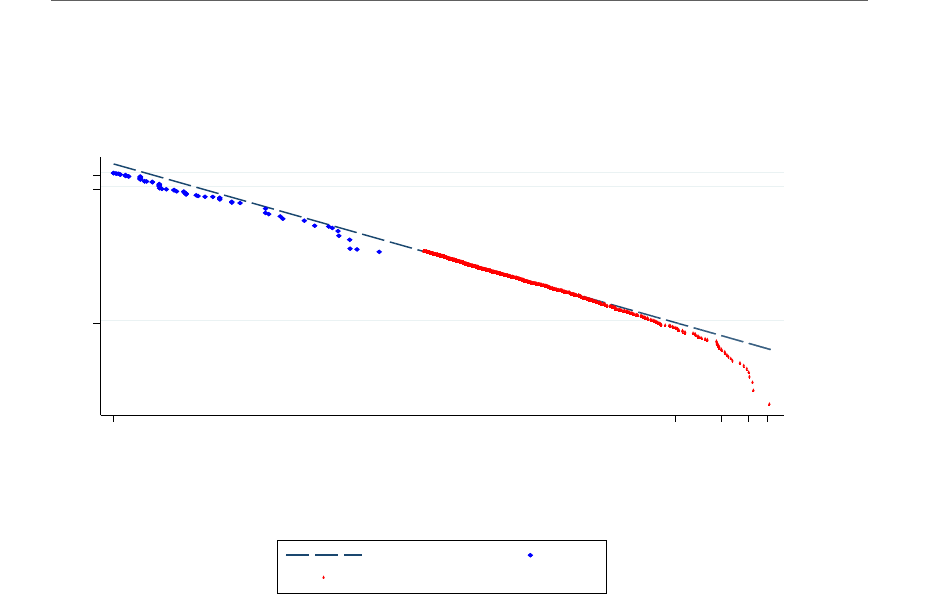
55
Appendix F: Sensitivity of Pareto estimation to alternative
thresholds and definitions
As discussed in Section 4, there are two key challenges in estimating the Pareto
distribution which underlies the top tail of the wealth distribution. First, accounting for
the difference in definition/coverage of wealth between the WAS and the STRL. Second,
identifying the appropriate threshold above which the true wealth distribution in the
UK can be approximated with a Pareto distribution. This appendix presents sensitivity
analysis for both of these issues.
Figure F1: Relying on WAS business assets alone does not materially change
the estimated distribution
Estimate Pareto distribution using WAS business assets and the STRL (lower bound
threshold of £1 million)
NOTES: Estimation suggests there is missing wealth in WAS/STRL relative to the fitted Pareto distribution
amounting to £470 billion.
Source ONS, Wealth and Assets Survey; Sunday Times Rich List.
Figure F1 and F2 present alternative definitions of wealth in the WAS combined with
the STRL and the fitted Pareto distribution. Figure F1 restricts wealth in the WAS to only
private business wealth as we can be confident that this is captured in the STRL as this
forms the key input to many top-wealth families’ assets. Figure F2 takes the opposite
approach and includes all wealth identified in the WAS. The definition of wealth used in
0
50
100
Percentage above (log scale)
1000000
5.001e+09
1.000e+10
1.500e+10
2.000e+10
Total household wealth (log scale)
Fitted Pareto WAS
ST Rich List
The UK’s wealth distribution and characteristics of high-wealth households |
Resolution Foundation

56
the main body of the paper remains our preferred specification, given the coverage of
the STRL. However, these results show that the Pareto distribution is a reasonably good
approximation regardless of WAS wealth definition.
Finally, Table F1 tabulates the resulting estimate of wealth missing from the WAS and
STRL samples, based on the fitted Pareto distribution generated under different wealth
definitions and thresholds.
Figure F2: Using WAS total wealth definition produces a worse fit for the
Pareto distribution
Estimated Pareto distribution using WAS measure of total wealth and the STRL (lower
bound threshold £1 million)
NOTES: Estimation suggests there is missing wealth in WAS/STRL relative to the fitted Pareto distribution
amounting to £950 billion.
Source ONS, Wealth and Assets Survey; Sunday Times Rich List.
As discussed in Section 4 of the paper, the Pareto adjustment results are very sensitive
to the definition of wealth, and to a lesser extent also sensitive to the threshold above
which the true underlying wealth distribution matches a Pareto distribution. This
table provides an indication of that sensitivity as well as the key estimation statistic –
the Pareto index alpha – which should be stable at the appropriate cut-off threshold
(Vermeulen, 2018). As the table shows, there is no clear indication of the appropriate
threshold when total household wealth is used. With our preferred measure of business
wealth, the choice of threshold makes very little difference to the Pareto index.
0
50
100
Percentage above (log scale)
1000000
5.001e+09
1.000e+10
1.500e+10
2.000e+10
Total household wealth (log scale)
Fitted Pareto WAS
ST Rich List
The UK’s wealth distribution and characteristics of high-wealth households |
Resolution Foundation

57
Table F1: Pareto adjustments are fairly consistent for different thresholds when
relying on business and financial wealth in the WAS
Summary results from Pareto adjustment based on different threshold levels and
definitions of wealth
NOTES: Estimates of additional wealth are similar across different thresholds using our preferred definition
of business wealth including shares. Excluding shares does not have a significant effect on the estimates.
Estimates based on total wealth are notably different and relatively more unstable when different
thresholds are used.
Source ONS, Wealth and Assets Survey; Sunday Times Rich List.
Threshold
Definition of WAS
wealth
Additional wealth
Pareto index
alpha
500k Business and financial +£330 billion 0.98
1m Business and financial +£360 billion 0.97
2m Business and financial +£400 billion 0.97
3m Business and financial +£430 billion 0.98
4m Business and financial +£440 billion 0.99
5m Business and financial +£440 billion 0.99
500k Business assets only +£460 billion 0.93
1m Business assets only +£470 billion 0.94
2m Business assets only +£490 billion 0.97
3m Business assets only +£490 billion 0.98
4m Business assets only +£480 billion 0.99
5m Business assets only +£470 billion 0.99
500k Total wealth +£1.0 trillion 1.57
1m Total wealth +£950 billion 1.56
2m Total wealth +£220 billion 1.45
3m Total wealth -£150 billion 1.32
4m Total wealth -£250 billion 1.20
5m Total wealth -£230 billion 1.14
6m Total wealth -£170 billion 1.10
7m Total wealth -£90 billion 1.07
8m Total wealth -£50 billion 1.05
9m Total wealth £0 billion 1.04
The UK’s wealth distribution and characteristics of high-wealth households |
Resolution Foundation

The Resolution Foundation is an independent think-tank focused
on improving living standards for those on low to middle incomes.
We work across a wide range of economic and social policy areas,
combining our core purpose with a commitment to analytical rigour.
These twin pillars of rigour and purpose underpin everything we do
and make us the leading UK authority on securing widely-shared
economic growth.
The Foundation’s established work programme focuses on incomes,
inequality and poverty; jobs, skills and pay; housing; wealth and
assets; tax and welfare; public spending and the shape of the state,
and economic growth.
For more information on this report, contact:
Jack Leslie
Economist
jack.leslie@resolutionfoundation.org
Resolution Foundation, 2 Queen Anne’s Gate , London, SW1H 9AA
Charity Number: 1114839 | resolutionfoundation.org/publications
